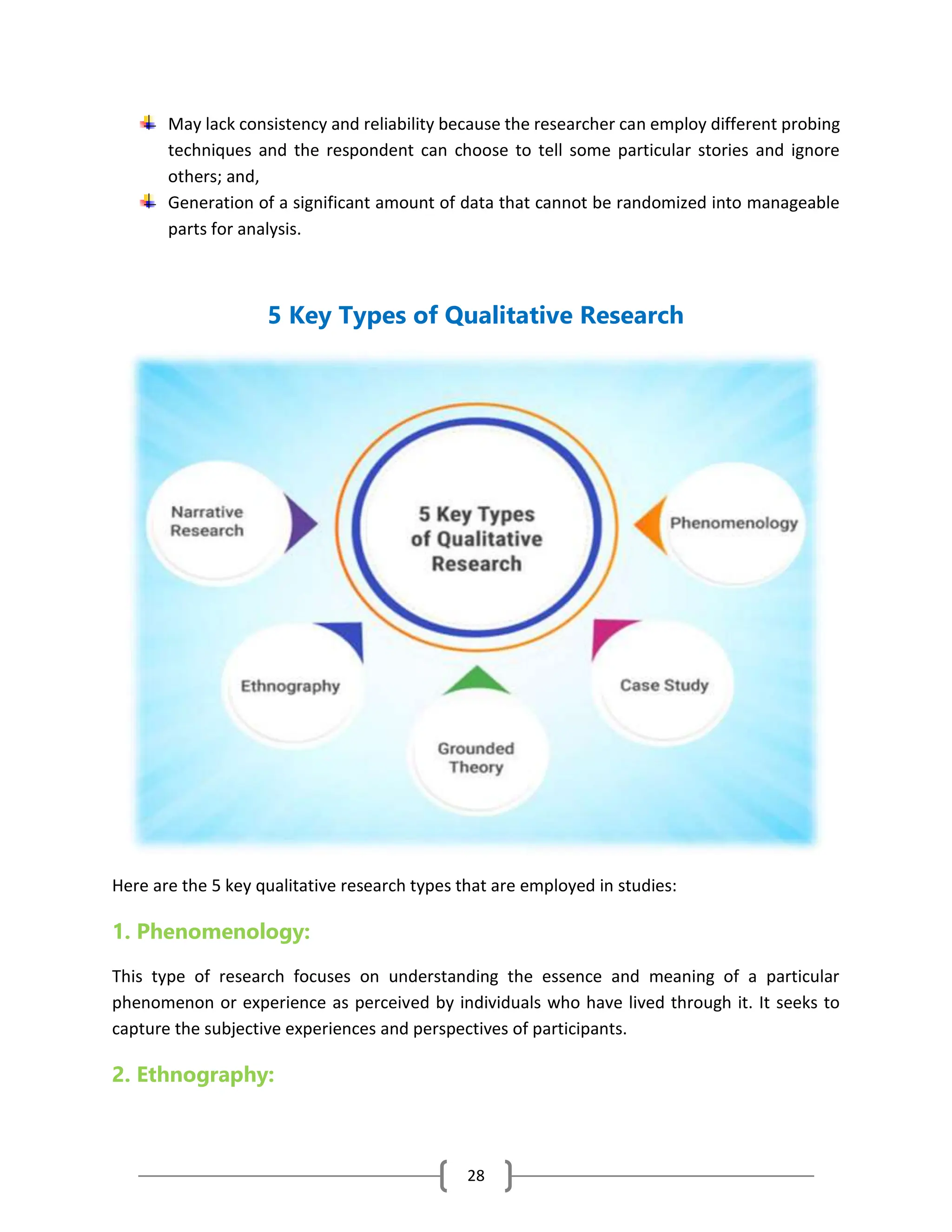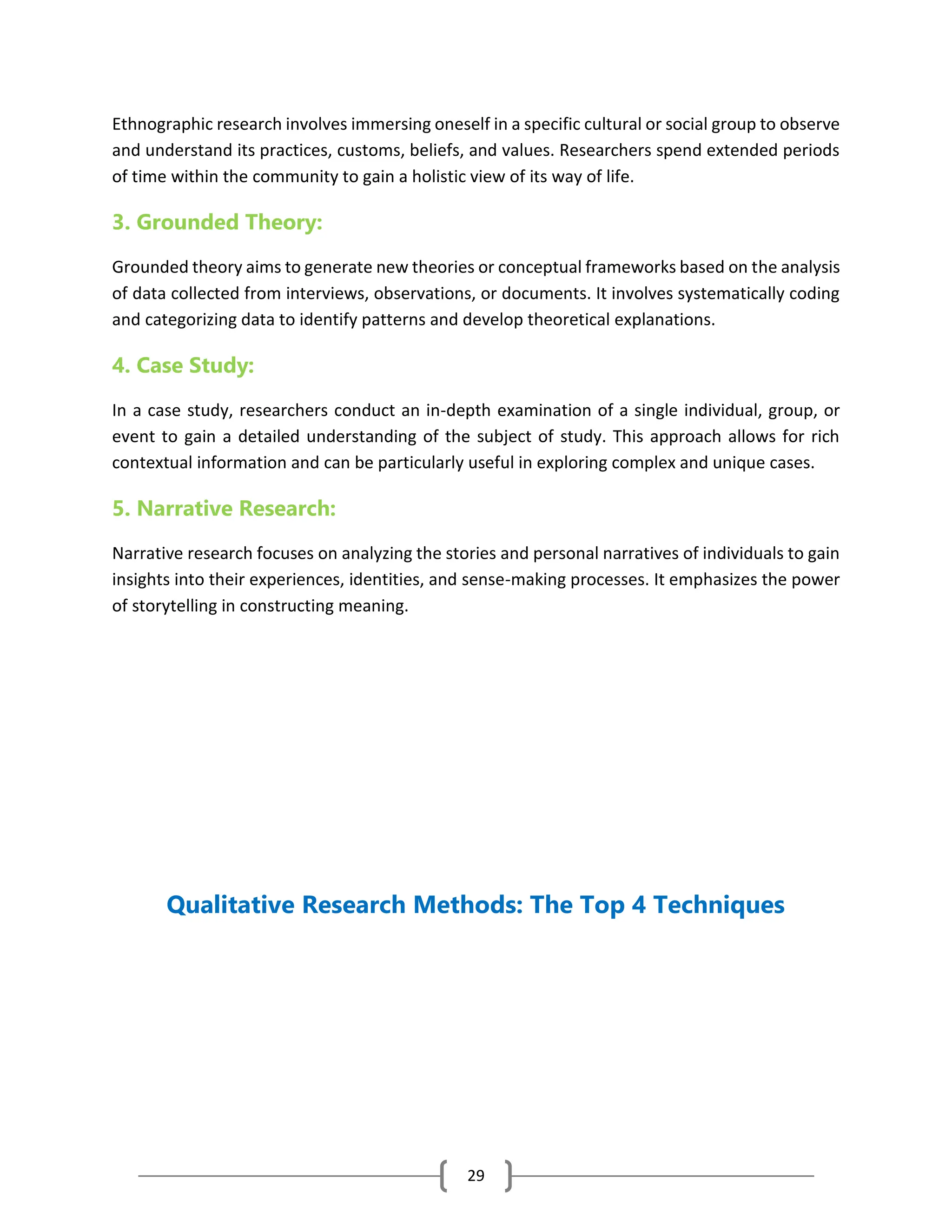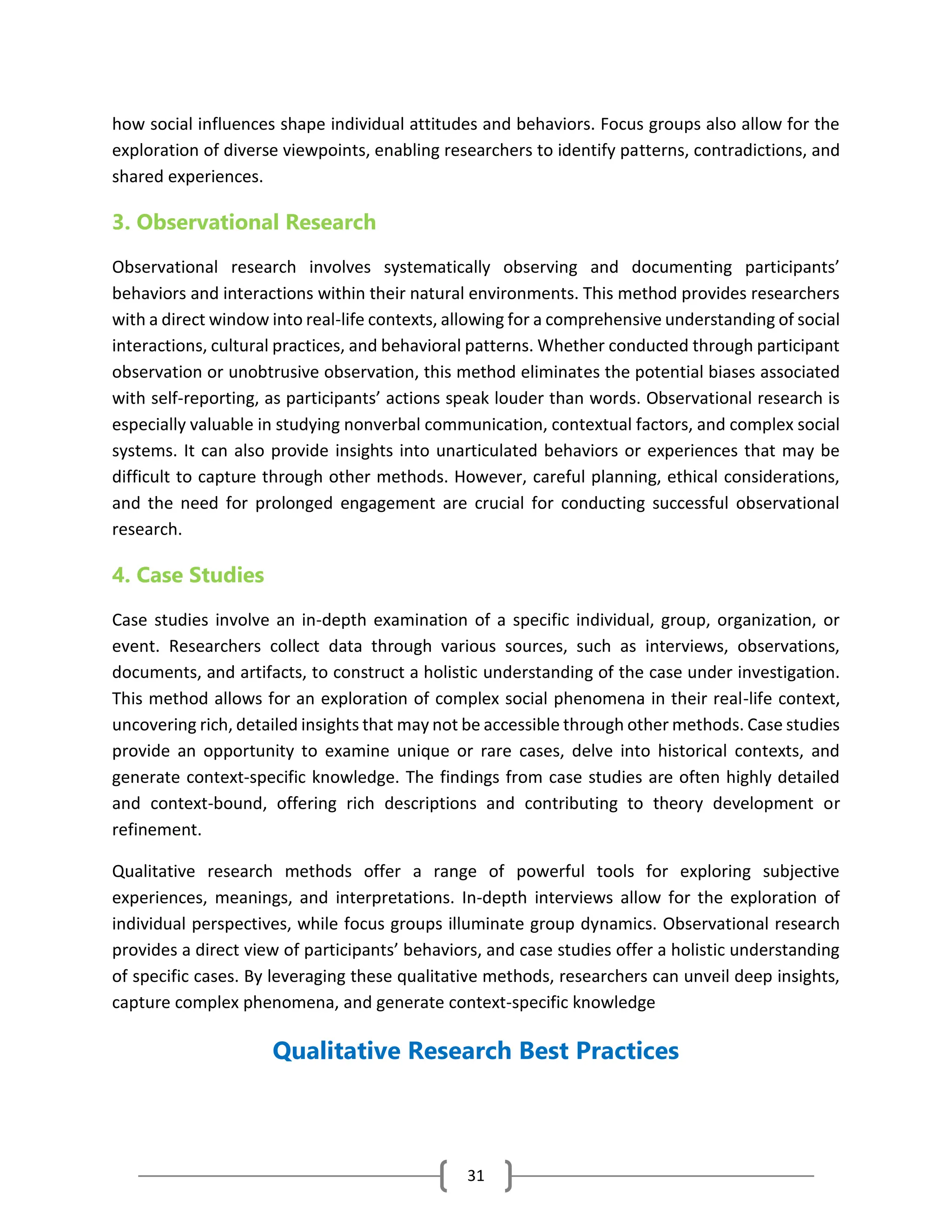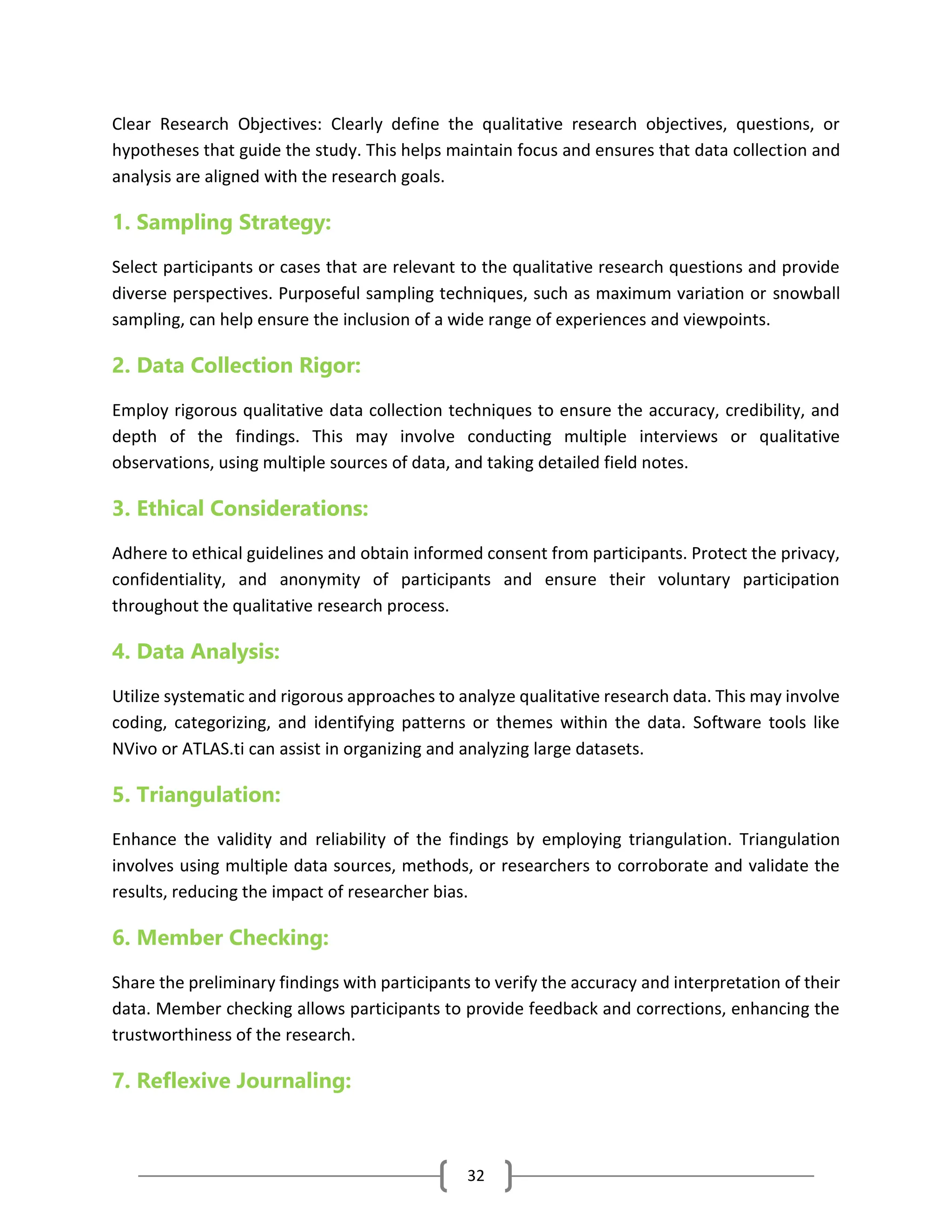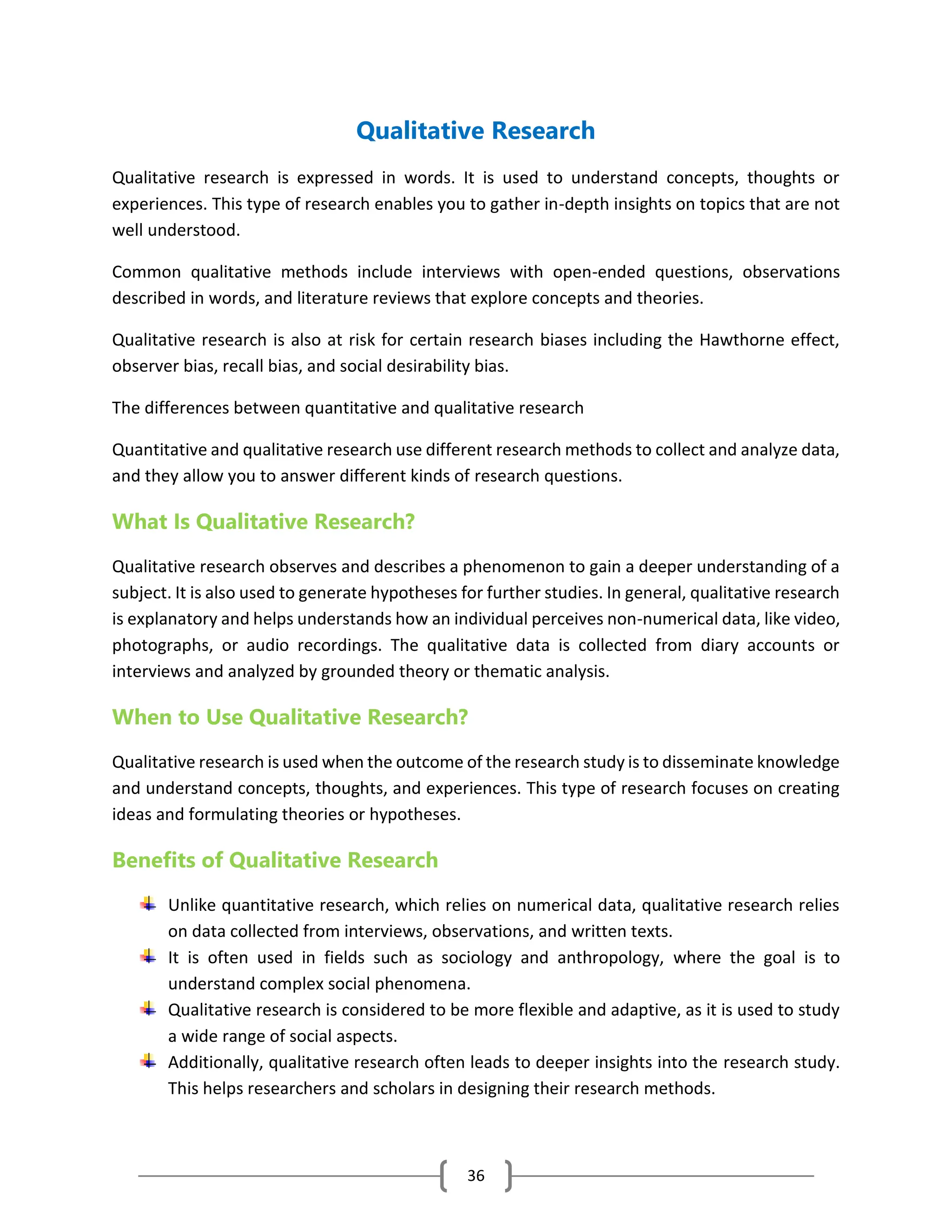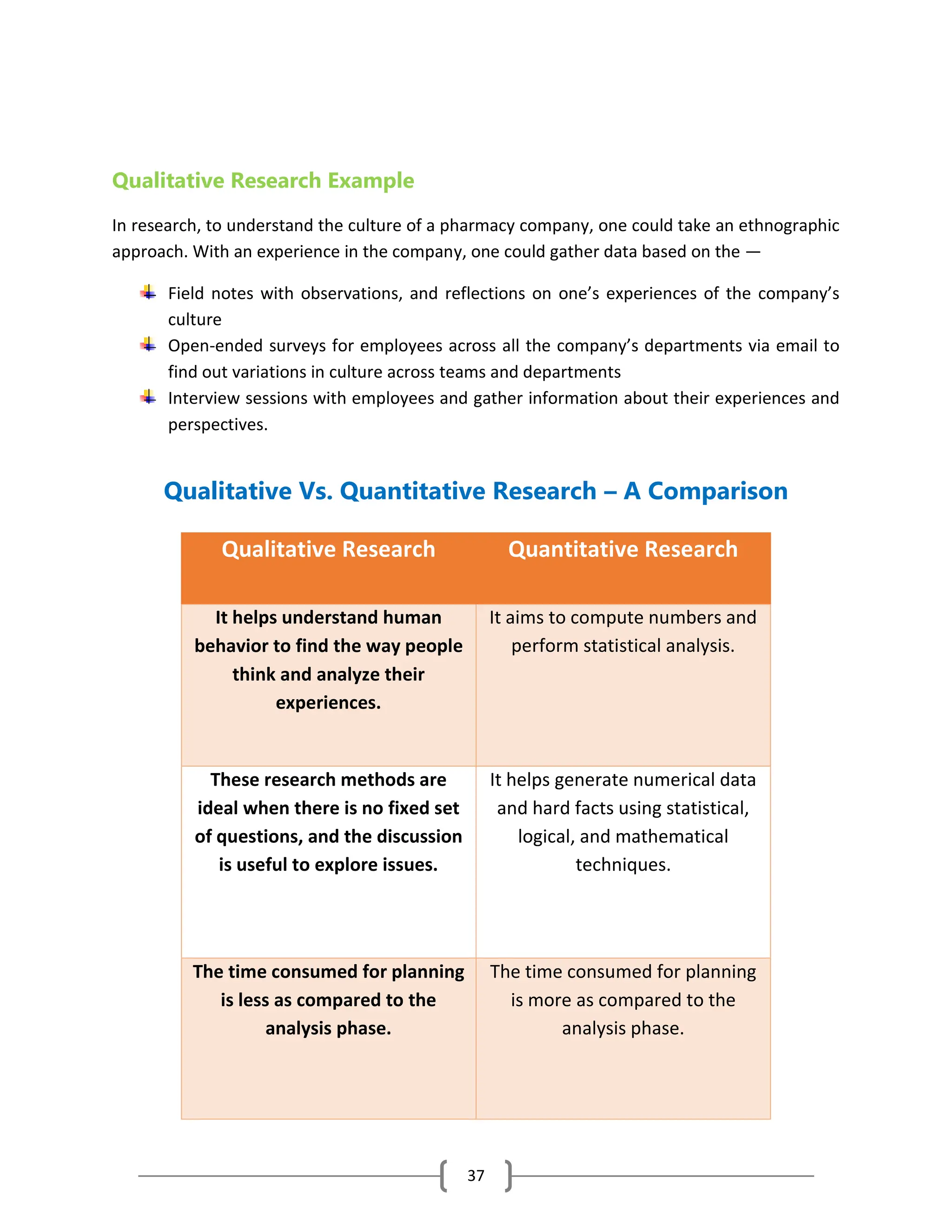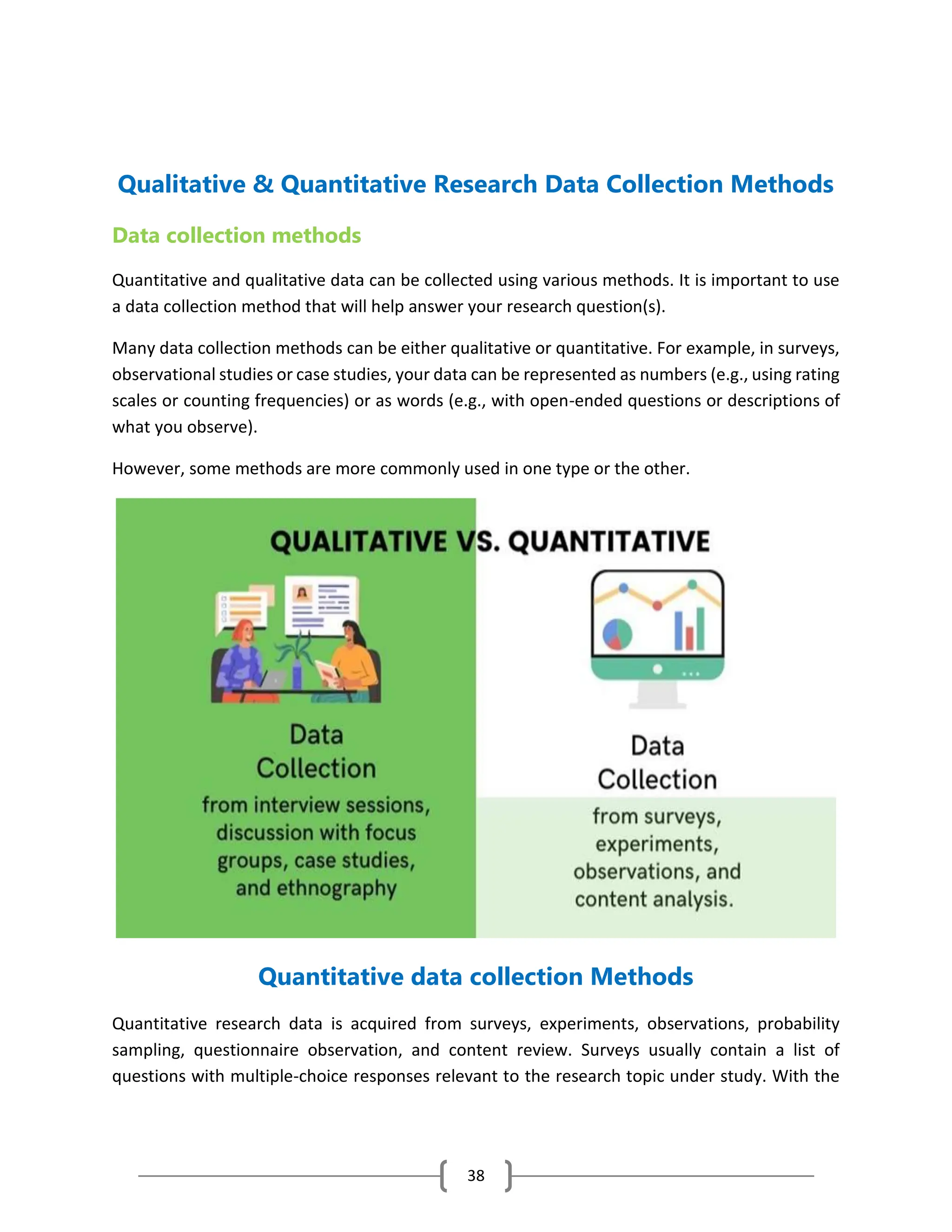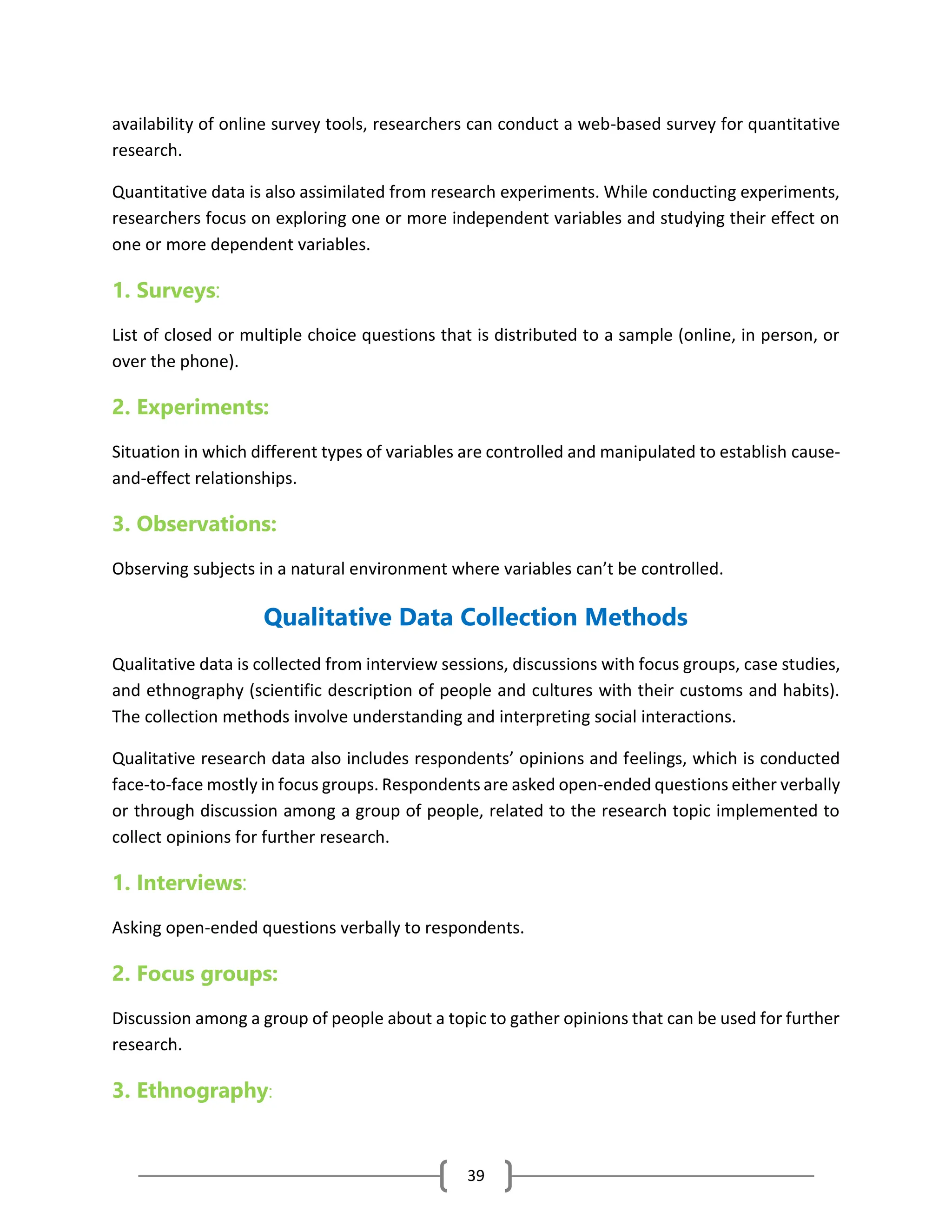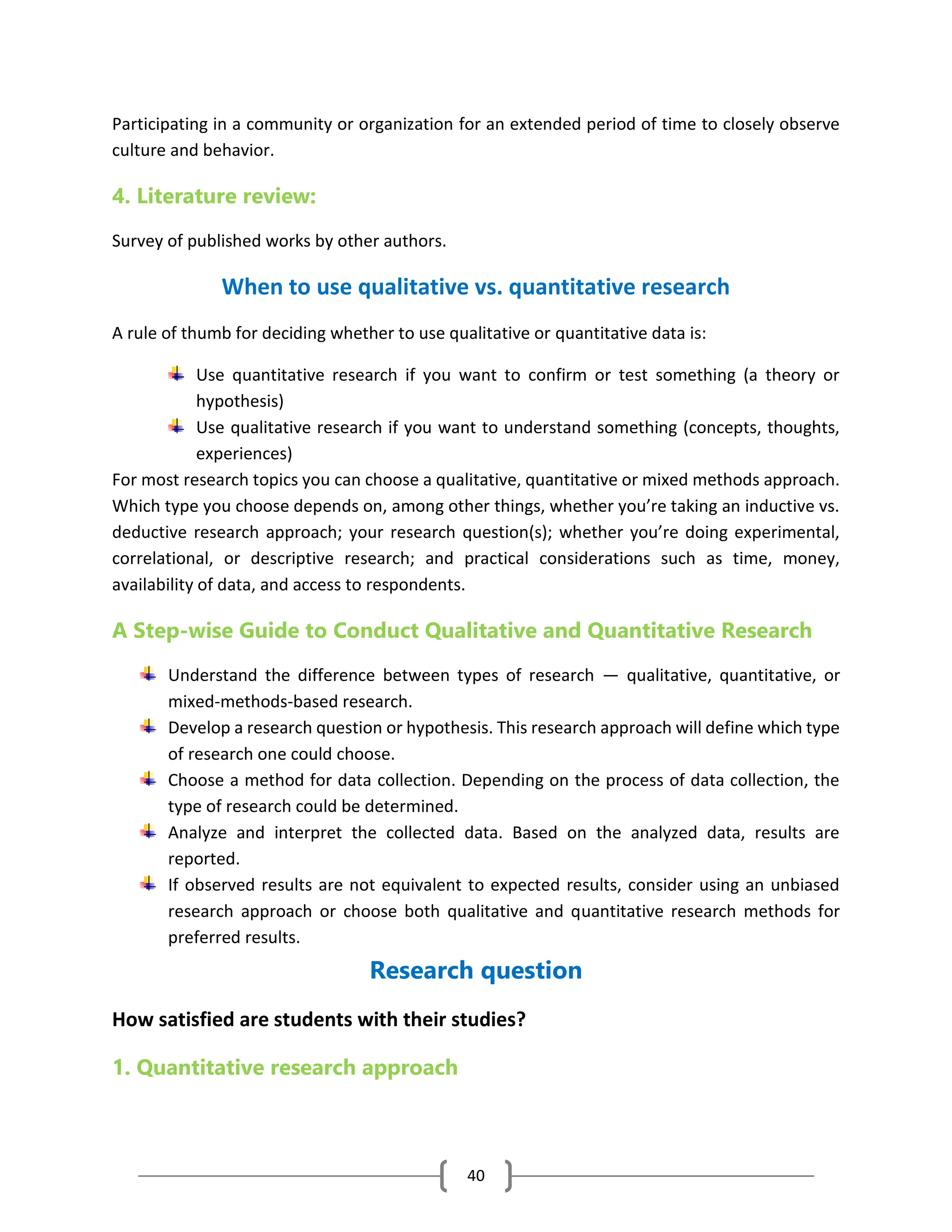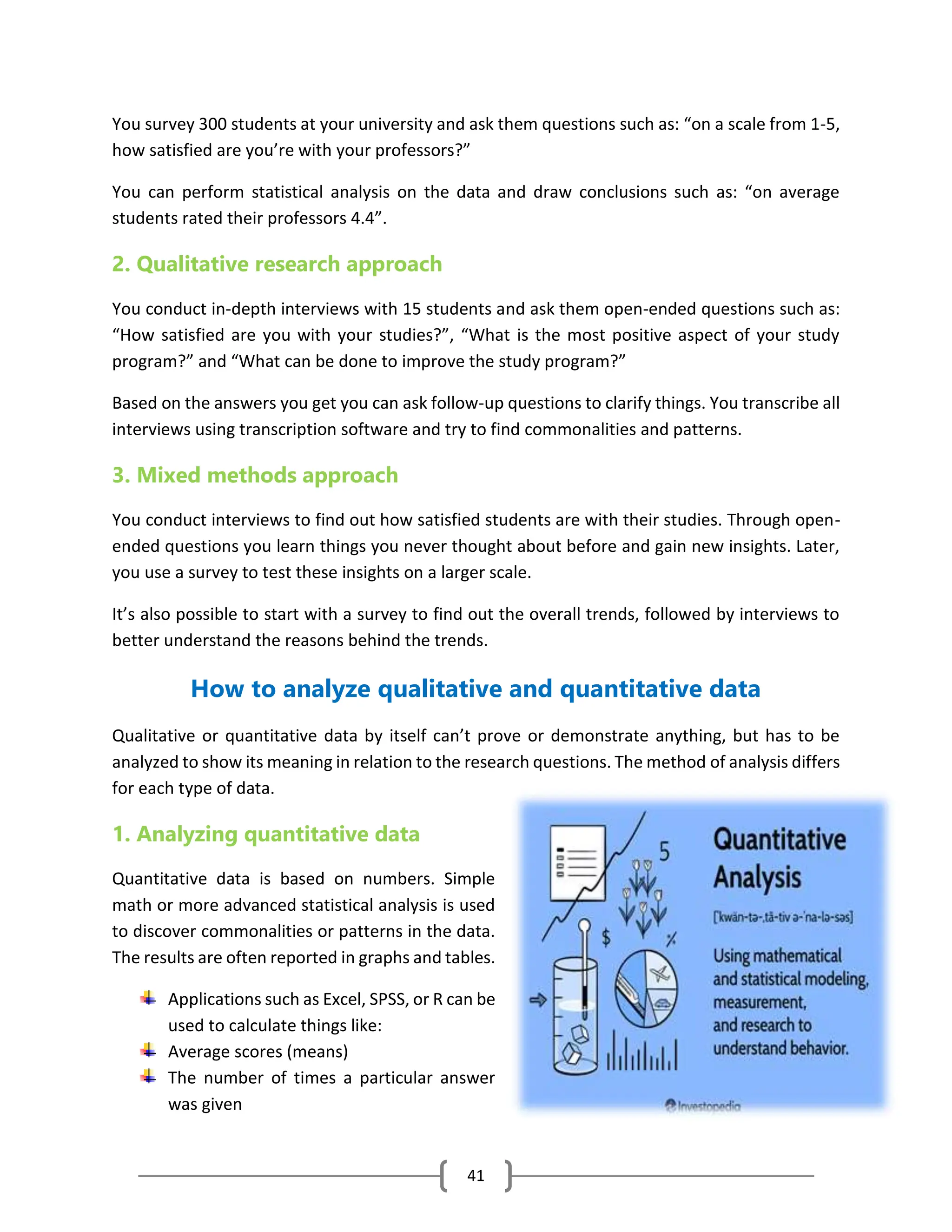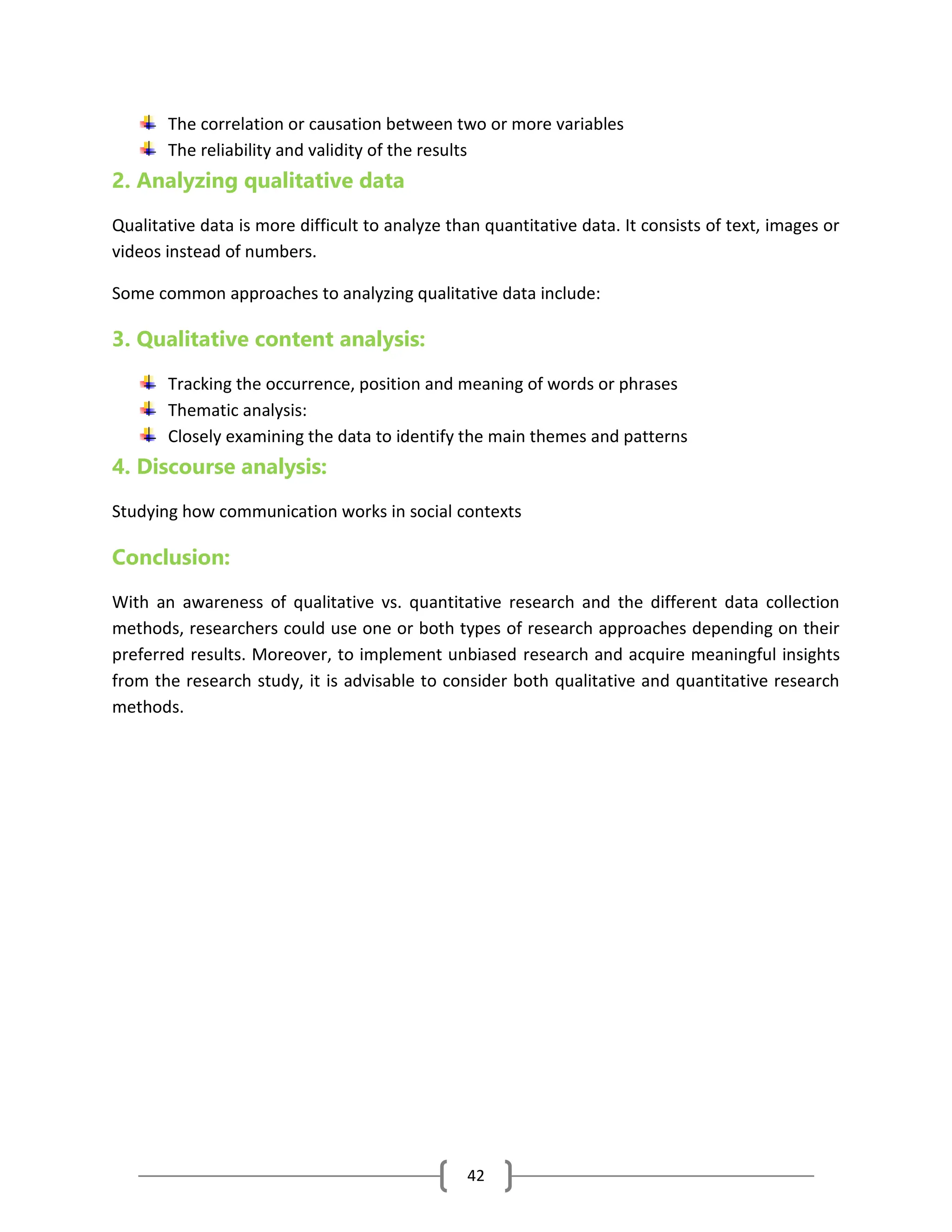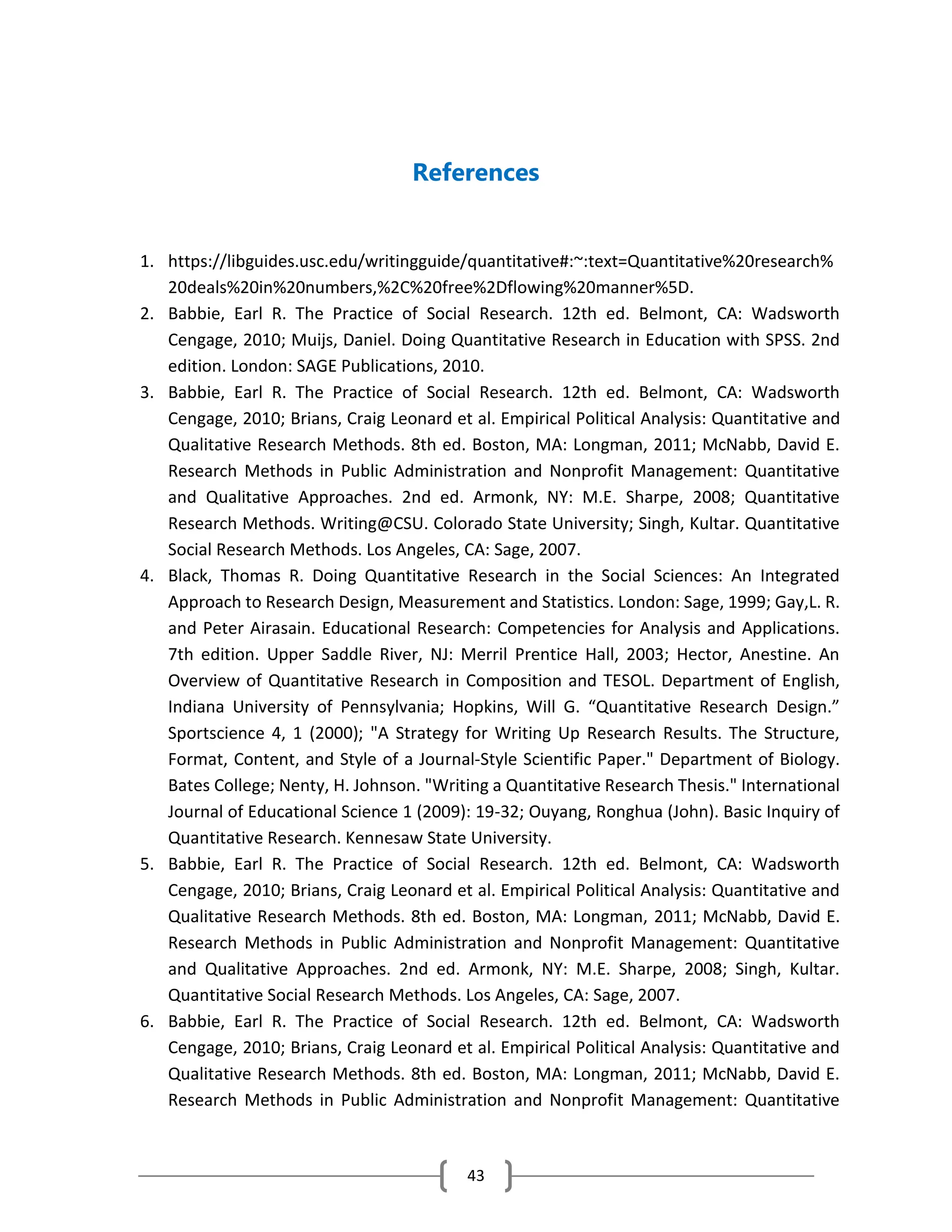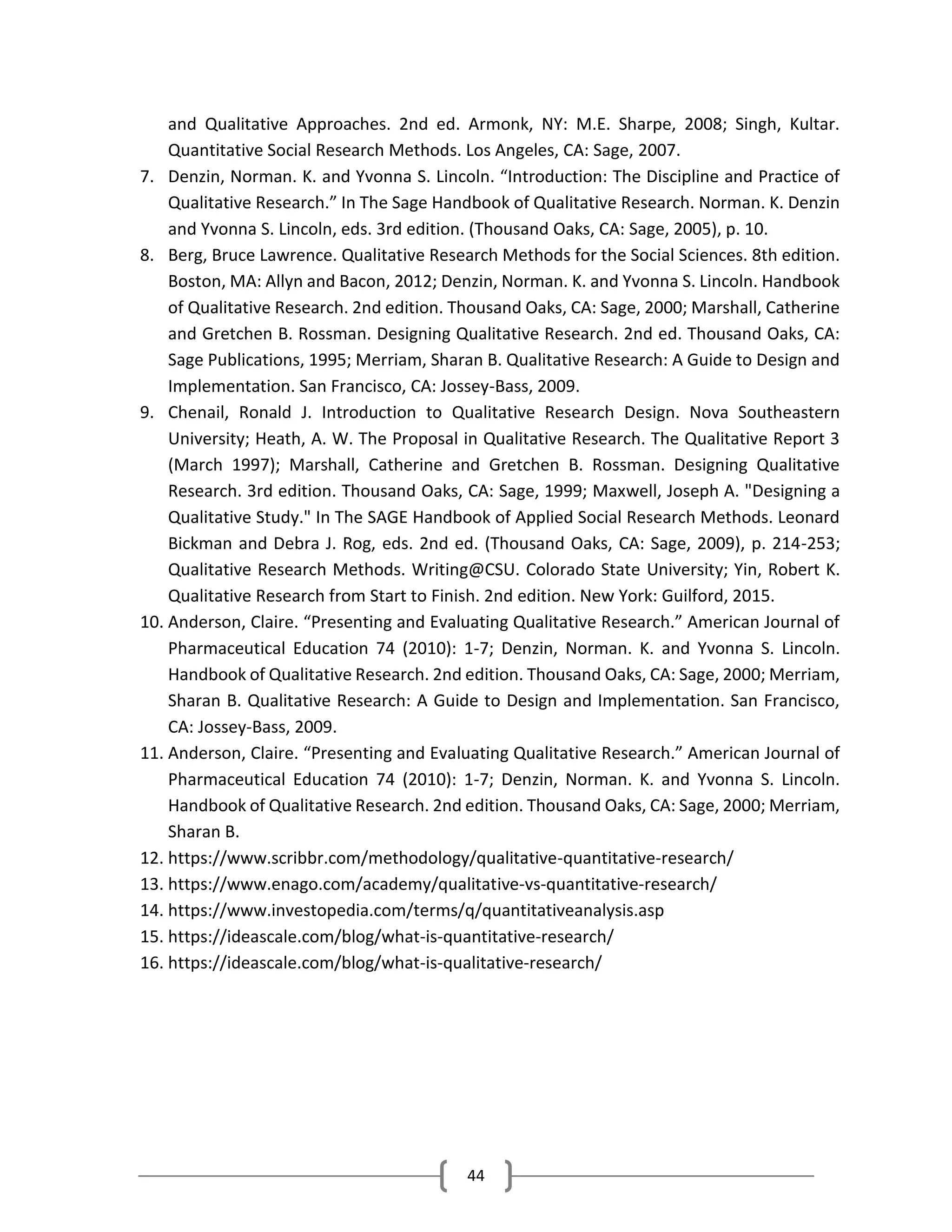The document provides a comprehensive overview of quantitative and qualitative research methods, detailing their definitions, key characteristics, advantages, and methodologies. It highlights the structured approach of quantitative research which emphasizes numeric data, objectivity, and statistical analysis, alongside the subjectivity and depth associated with qualitative research. Additionally, best practices for both methods and a comparison between them are discussed, offering insights into when to utilize each approach.
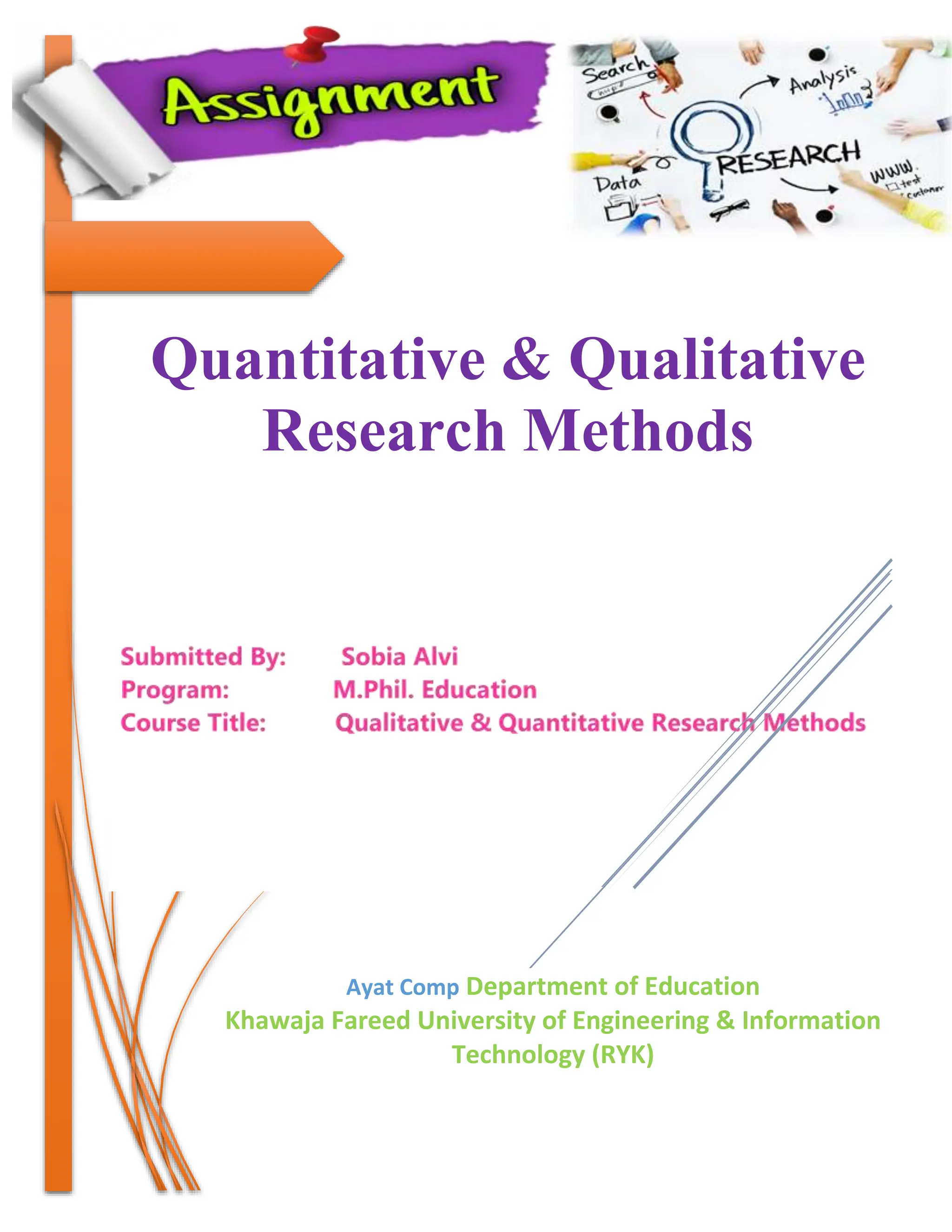
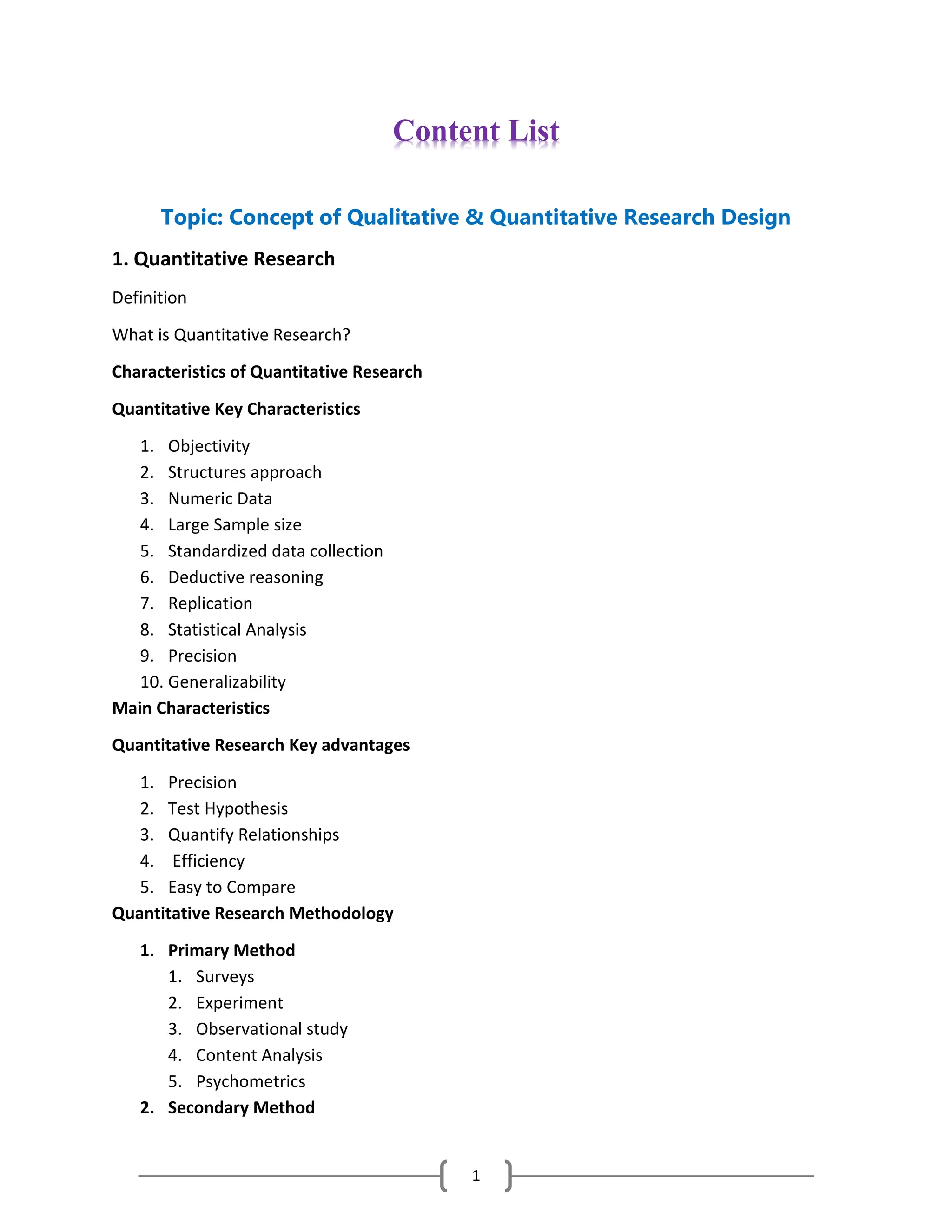
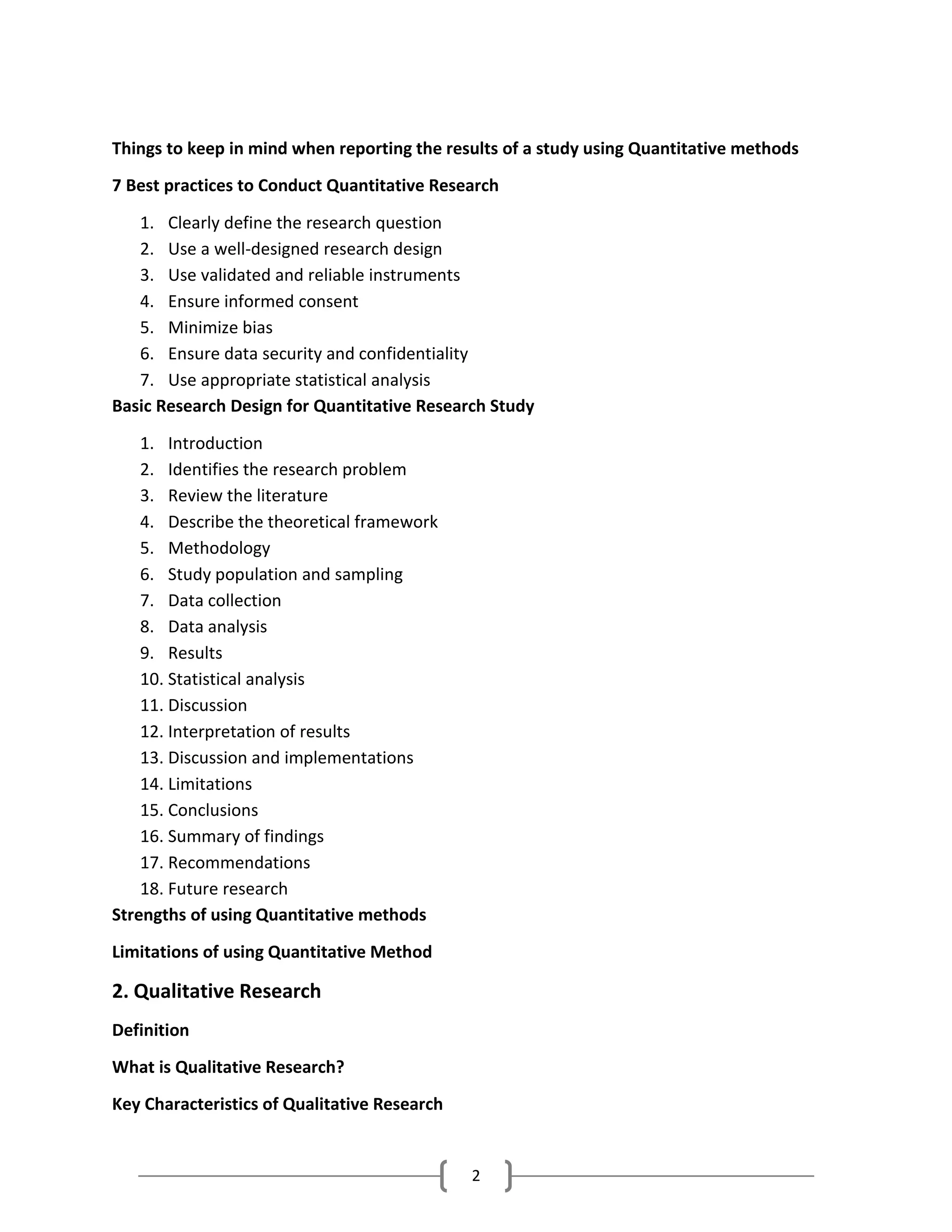
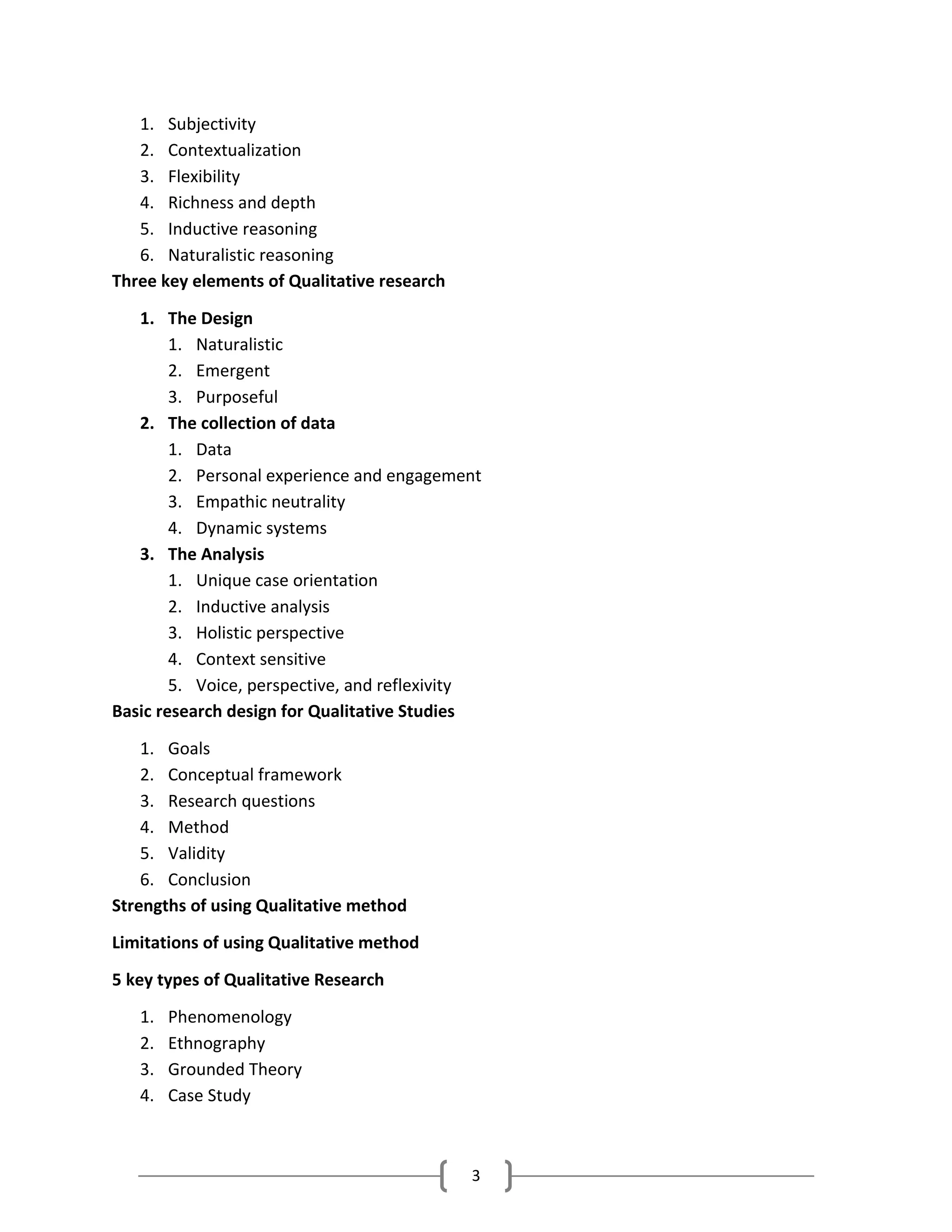
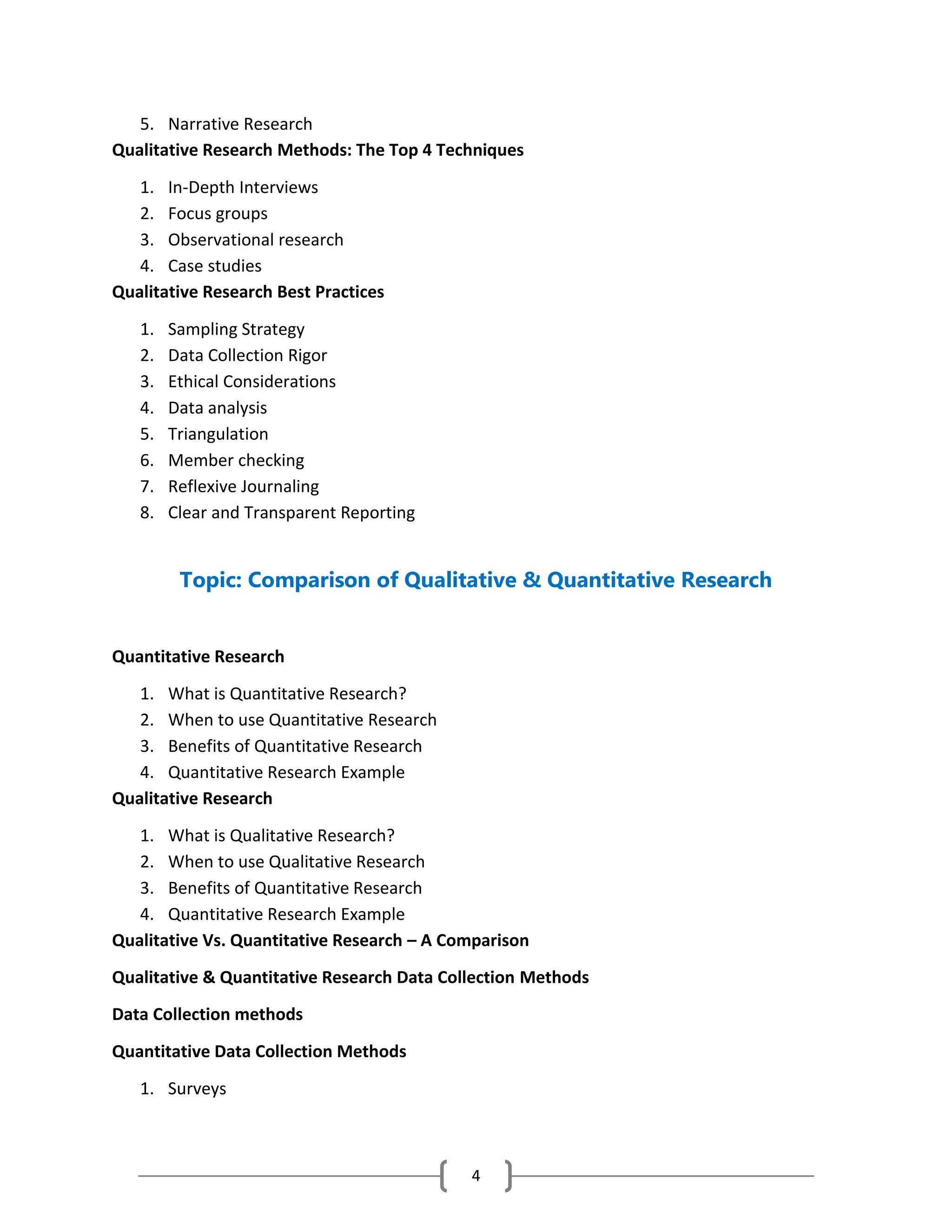
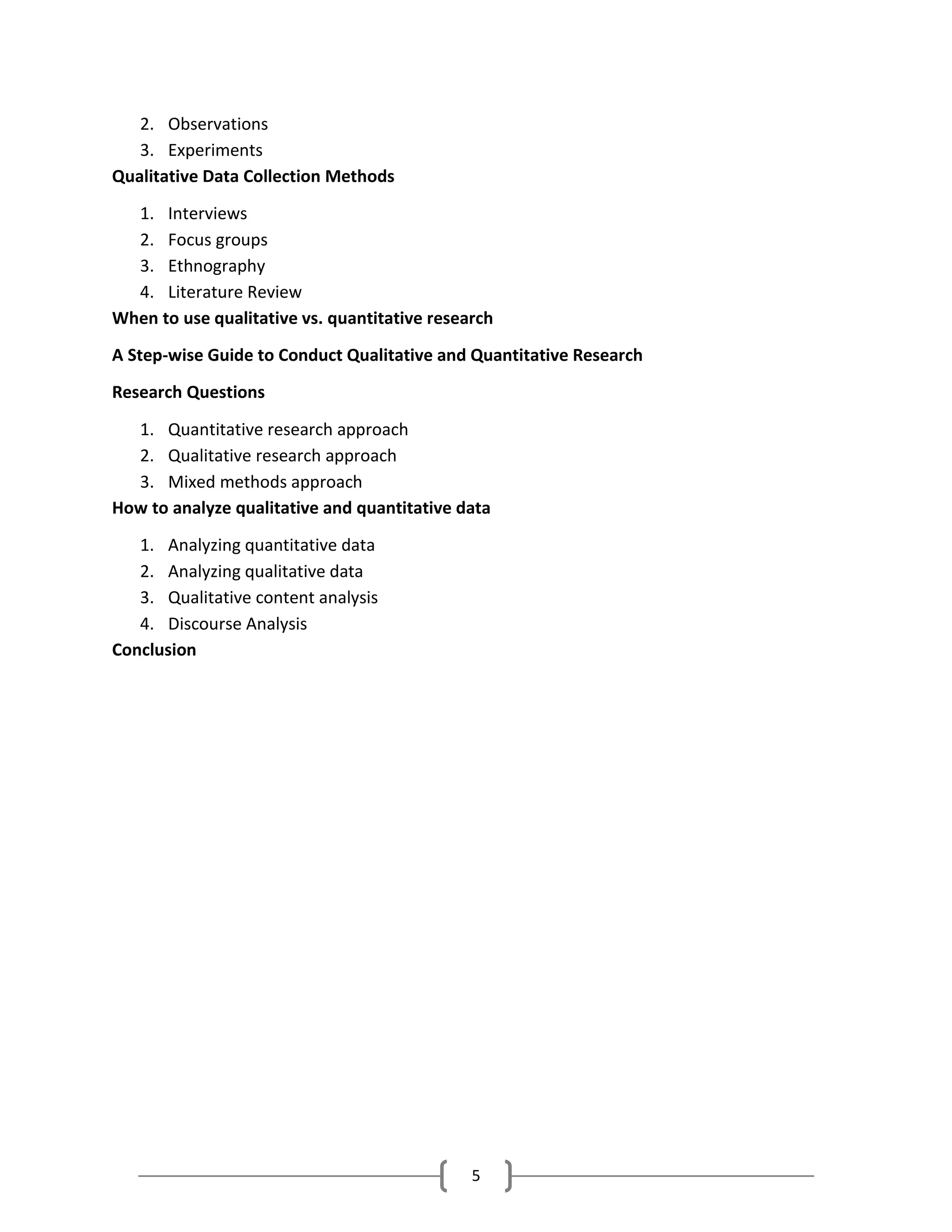
![6
Topic: Concept of Qualitative & Quantitative
Research Design
Quantitative Research
Definition
Quantitative methods emphasize objective measurements and the statistical, mathematical, or
numerical analysis of data collected through polls, questionnaires, and surveys, or by
manipulating pre-existing statistical data using computational techniques. Quantitative research
focuses on gathering numerical data and generalizing it across groups of people or to explain a
particular phenomenon.
What is Quantitative Research?
Quantitative research stands as a powerful research methodology dedicated to the systematic
collection and analysis of measurable data. Through rigorous statistical and mathematical
techniques, this method extracts insights from structured surveys, controlled experiments, or
other defined data-gathering methods.
The primary objective of quantitative research is to measure and quantify variables,
relationships, and patterns within the dataset. By testing hypotheses, making predictions, and
drawing generalizable conclusions, it plays a crucial role in fields such as psychology, sociology,
economics, and education. This approach often involves significant sample sizes, ensuring robust
results.
Explore the depth of quantitative research with this comprehensive guide, offering practical
examples and applications to demonstrate its real-world impact. Stay updated with the latest
trends and developments in quantitative research as we continually refine our insights to provide
you with the most relevant and cutting-edge information.
Characteristics of Quantitative Research
Your goal in conducting quantitative research study is to determine the relationship between one
thing [an independent variable] and another [a dependent or outcome variable] within a
population. Quantitative research designs are either descriptive [subjects usually measured](https://image.slidesharecdn.com/qualitativequantitativeresearchmethods-240428113434-0bb40fc2/75/Qualitative-Quantitative-Research-Methods-docx-7-2048.jpg)
![7
once] or experimental [subjects measured before and after a treatment]. A descriptive study
establishes only associations between variables; an experimental study establishes causality.
Quantitative research deals in numbers, logic, and an objective stance. Quantitative research
focuses on numeric and unchanging data and detailed, convergent reasoning rather than
divergent reasoning [i.e., the generation of a variety of ideas about a research problem in a
spontaneous, free-flowing manner].
Quantitative Research: Key Characteristics
Below are the key characteristics of quantitative research:
1. Objectivity:
Quantitative research is grounded in the principles of objectivity and empiricism, which means
that the research is focused on observable and measurable phenomena, rather than personal
opinions or experiences.
2. Structured approach:](https://image.slidesharecdn.com/qualitativequantitativeresearchmethods-240428113434-0bb40fc2/75/Qualitative-Quantitative-Research-Methods-docx-8-2048.jpg)


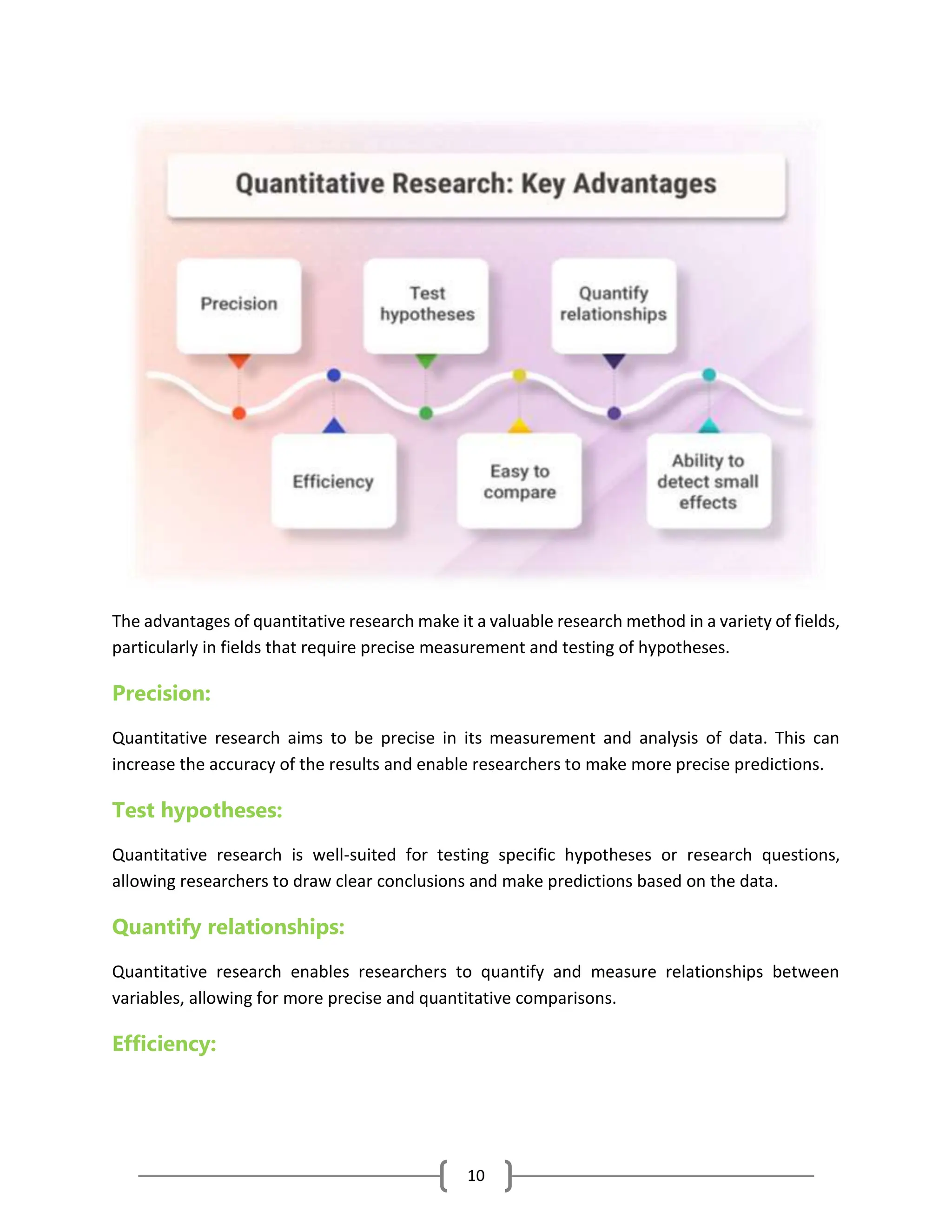
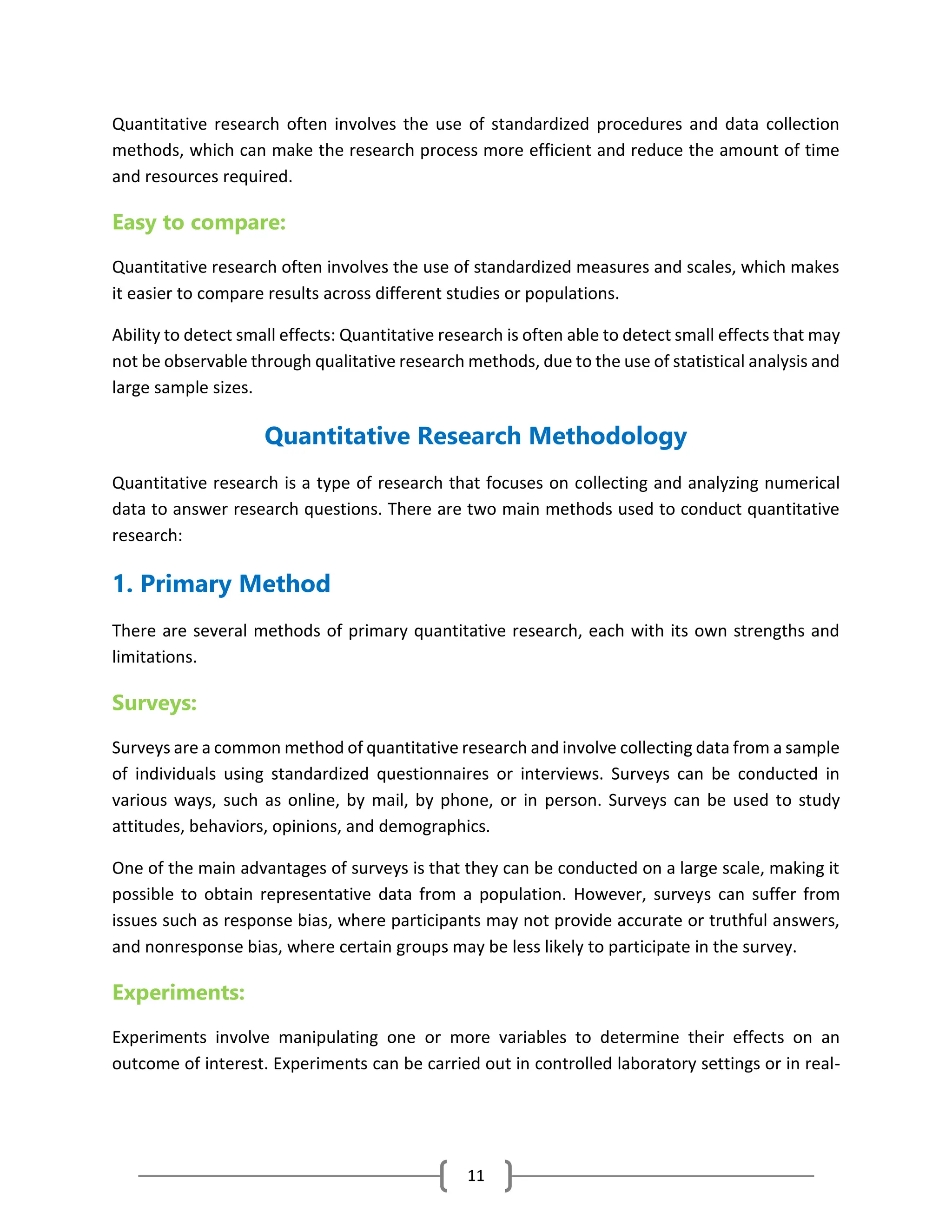

![13
differences in psychological traits and to assess the validity and reliability of psychological
measures.
One of the main advantages of psychometrics is that it can provide a standardized and objective
way to measure psychological constructs. However, psychometrics can suffer from issues such
as the cultural specificity of the measures and the potential for response bias in self-report
measures.
2. Secondary Method
Secondary quantitative research methods involve analyzing existing data that was collected for
other purposes. This can include data from government records, public opinion polls, or market
research studies. Secondary research is often quicker and less expensive than primary research,
but it may not provide data that is as specific to the research question.
One of the main advantages of secondary data analysis is that it can be a cost-effective way to
obtain large amounts of data. However, secondary data analysis can suffer from issues such as
the quality and relevance of the data, and the potential for missing or incomplete data.
Things to keep in mind when reporting the results of a study using
Quantitative methods
Explain the data collected and their statistical treatment as well as all relevant results
in relation to the research problem you are investigating. Interpretation of results is
not appropriate in this section.
Report unanticipated events that occurred during your data collection. Explain how
the actual analysis differs from the planned analysis. Explain your handling of missing
data and why any missing data does not undermine the validity of your analysis.
Explain the techniques you used to "clean" your data set.
Choose a minimally sufficient statistical procedure; provide a rationale for its use and
a reference for it. Specify any computer programs used.
Describe the assumptions for each procedure and the steps you took to ensure that
they were not violated.
When using inferential statistics, provide the descriptive statistics, confidence
intervals, and sample sizes for each variable as well as the value of the test statistic,
its direction, the degrees of freedom, and the significance level [report the actual p
value].
Avoid inferring causality, particularly in nonrandomized designs or without further
experimentation.](https://image.slidesharecdn.com/qualitativequantitativeresearchmethods-240428113434-0bb40fc2/75/Qualitative-Quantitative-Research-Methods-docx-14-2048.jpg)
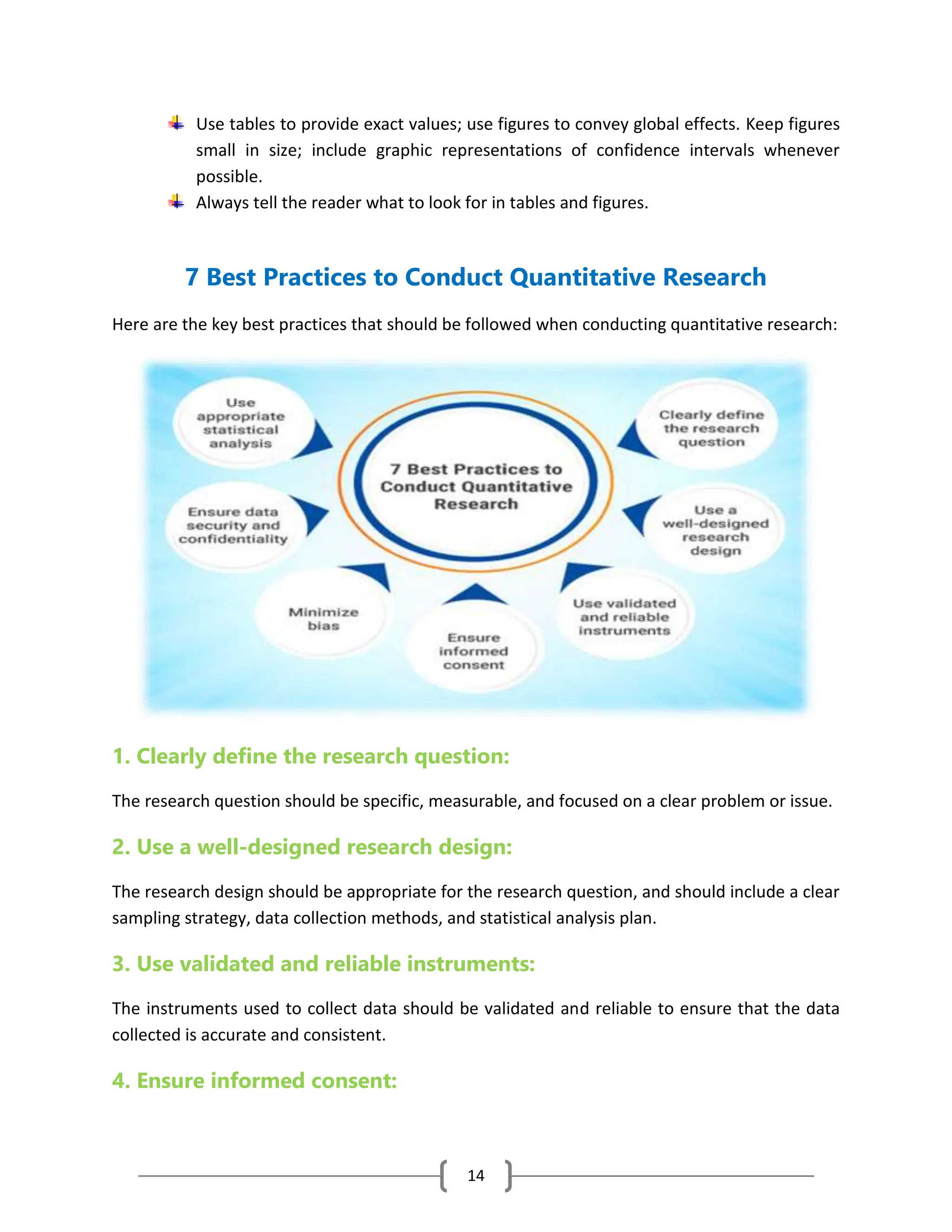
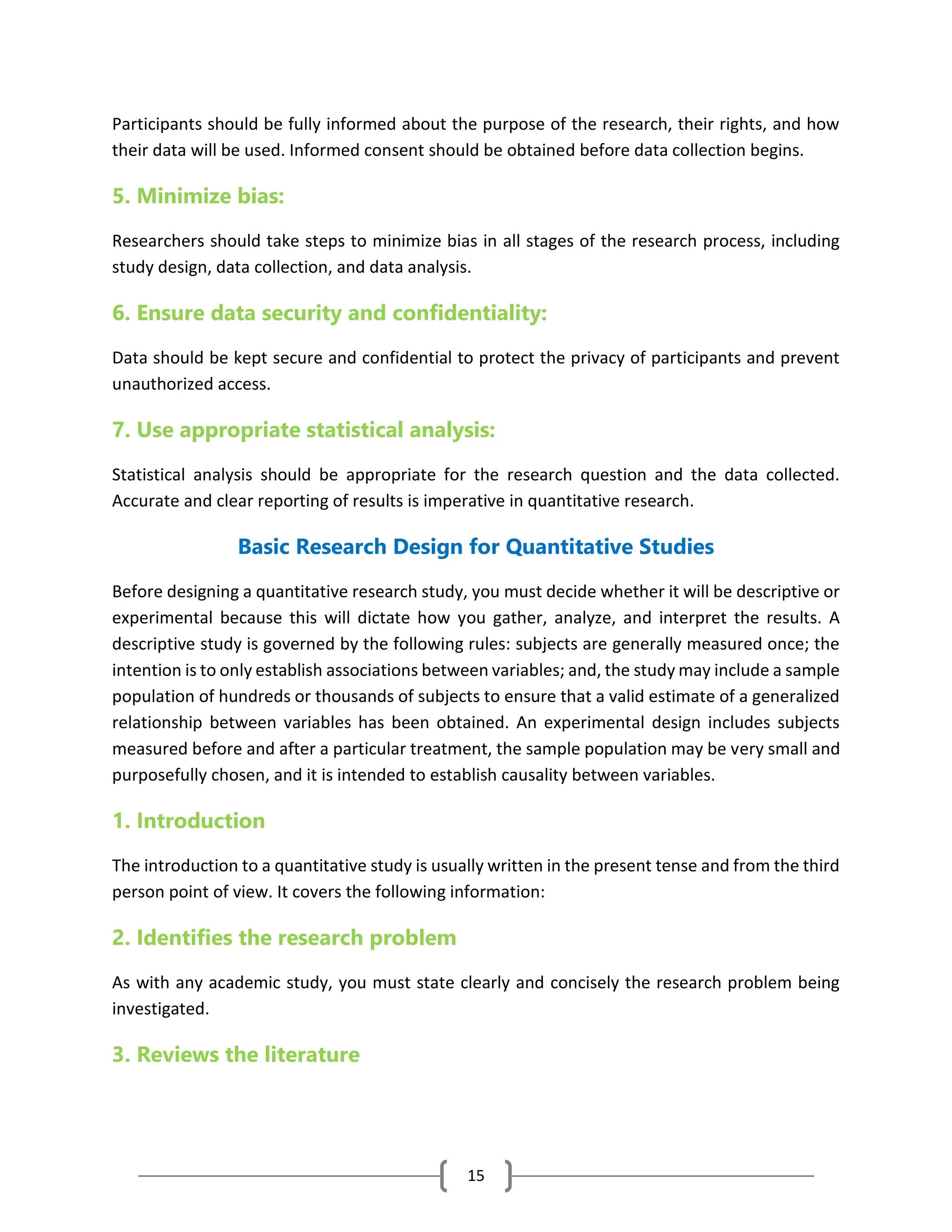
![16
Review scholarship on the topic, synthesizing key themes and, if necessary, noting studies that
have used similar methods of inquiry and analysis. Note where key gaps exist and how your study
helps to fill these gaps or clarifies existing knowledge.
4. Describes the theoretical framework
Provide an outline of the theory or hypothesis underpinning your study. If necessary, define
unfamiliar or complex terms, concepts, or ideas and provide the appropriate background
information to place the research problem in proper context [e.g., historical, cultural, economic,
etc.].
5. Methodology
The methods section of a quantitative study should describe how each objective of your study
will be achieved. Be sure to provide enough detail to enable the reader can make an informed
assessment of the methods being used to obtain results associated with the research problem.
The methods section should be presented in the past tense.
6. Study population and sampling
Where did the data come from; how robust is it; note where gaps exist or what was excluded.
Note the procedures used for their selection;
7. Data collection
describe the tools and methods used to collect information and identify the variables being
measured; describe the methods used to obtain the data; and, note if the data was pre-existing
[i.e., government data] or you gathered it yourself. If you gathered it yourself, describe what type
of instrument you used and why. Note that no data set is perfect--describe any limitations in
methods of gathering data.
8. Data analysis
Describe the procedures for processing and analyzing the data. If appropriate, describe the
specific instruments of analysis used to study each research objective, including mathematical
techniques and the type of computer software used to manipulate the data.
9. Results
The finding of your study should be written objectively and in a succinct and precise format. In
quantitative studies, it is common to use graphs, tables, charts, and other non-textual elements](https://image.slidesharecdn.com/qualitativequantitativeresearchmethods-240428113434-0bb40fc2/75/Qualitative-Quantitative-Research-Methods-docx-17-2048.jpg)
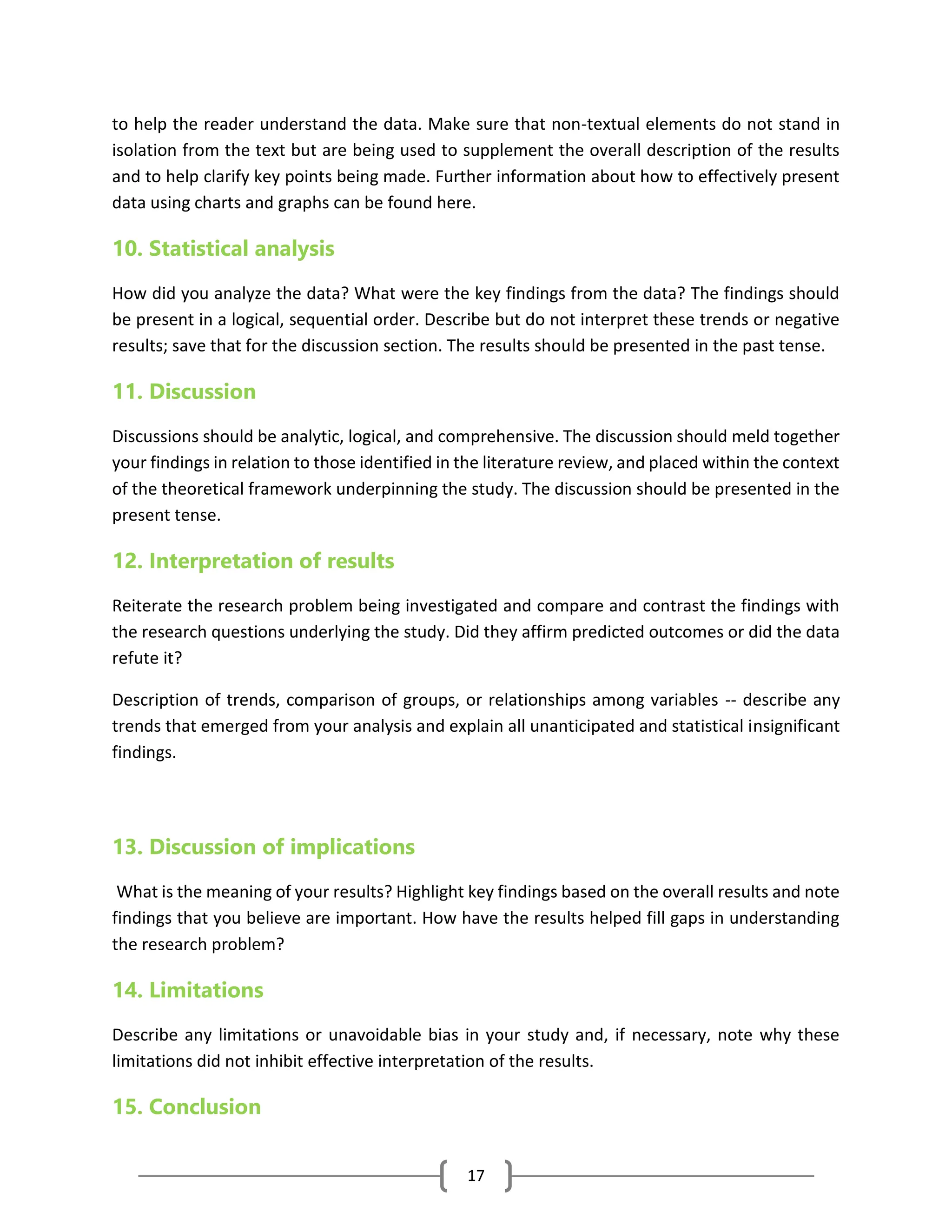

![19
Personal bias can be avoided by keeping a 'distance' from participating subjects and
using accepted computational techniques.
Limitations of Using Quantitative Methods
Quantitative methods presume to have an objective approach to studying research problems,
where data is controlled and measured, to address the accumulation of facts, and to determine
the causes of behavior. As a consequence, the results of quantitative research may be statistically
significant but are often humanly insignificant.
Some specific limitations associated with using quantitative methods to study research problems
in the social sciences include:
Quantitative data is more efficient and able to test hypotheses, but may miss contextual
detail;
Uses a static and rigid approach and so employs an inflexible process of discovery;
The development of standard questions by researchers can lead to "structural bias" and
false representation, where the data actually reflects the view of the researcher instead
of the participating subject;
Results provide less detail on behavior, attitudes, and motivation;
Researcher may collect a much narrower and sometimes superficial dataset;
Results are limited as they provide numerical descriptions rather than detailed narrative
and generally provide less elaborate accounts of human perception;
The research is often carried out in an unnatural, artificial environment so that a level of
control can be applied to the exercise. This level of control might not normally be in place
in the real world thus yielding "laboratory results" as opposed to "real world results"; and,
Preset answers will not necessarily reflect how people really feel about a subject and, in
some cases, might just be the closest match to the preconceived hypothesis.
Qualitative Research
Definition
The word qualitative implies an emphasis on the qualities of entities and on processes and
meanings that are not experimentally examined or measured [if measured at all] in terms of
quantity, amount, intensity, or frequency. Qualitative researchers stress the socially constructed
nature of reality, the intimate relationship between the researcher and what is studied, and the
situational constraints that shape inquiry. Such researchers emphasize the value-laden nature of
inquiry. They seek answers to questions that stress how social experience is created and given
meaning. In contrast, quantitative studies emphasize the measurement and analysis of causal](https://image.slidesharecdn.com/qualitativequantitativeresearchmethods-240428113434-0bb40fc2/75/Qualitative-Quantitative-Research-Methods-docx-20-2048.jpg)
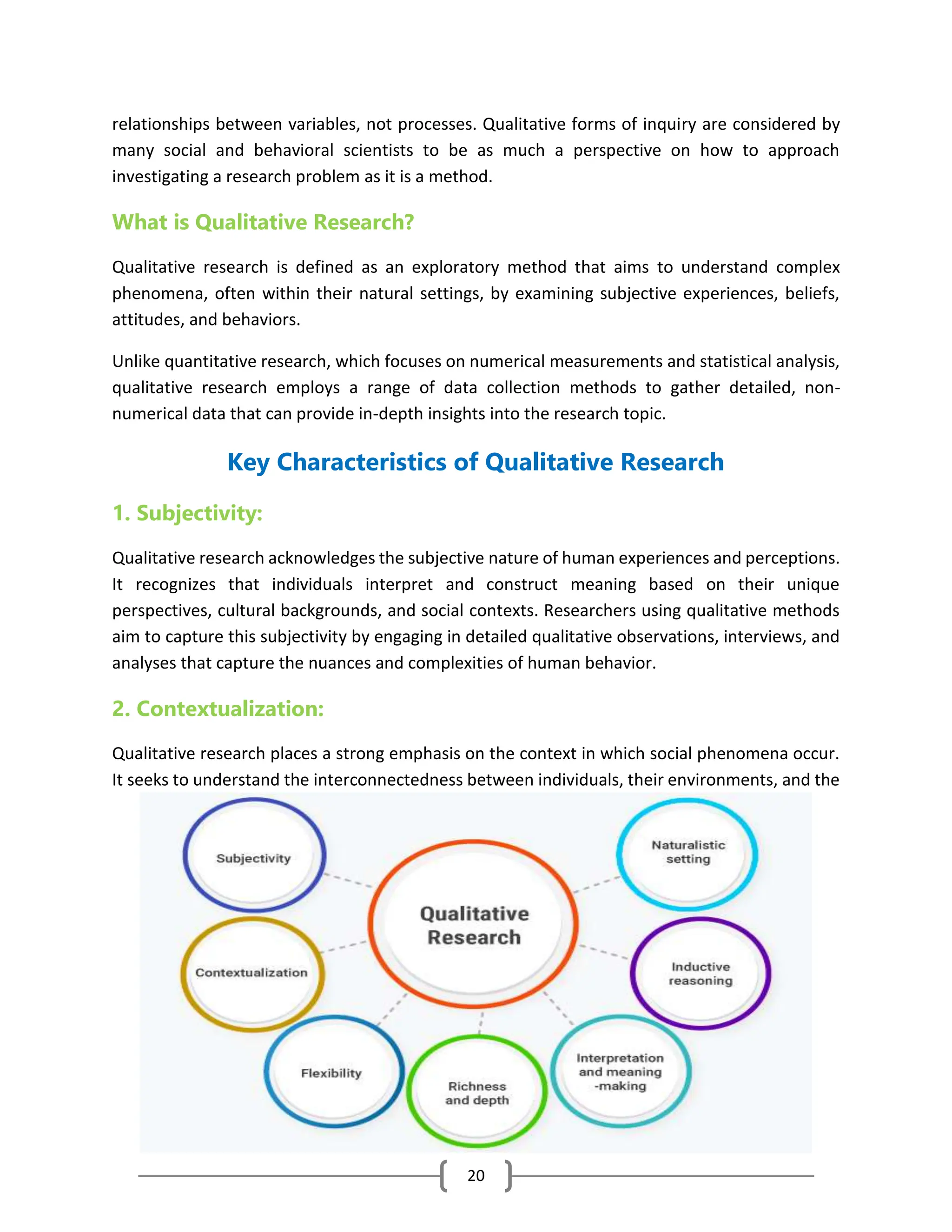
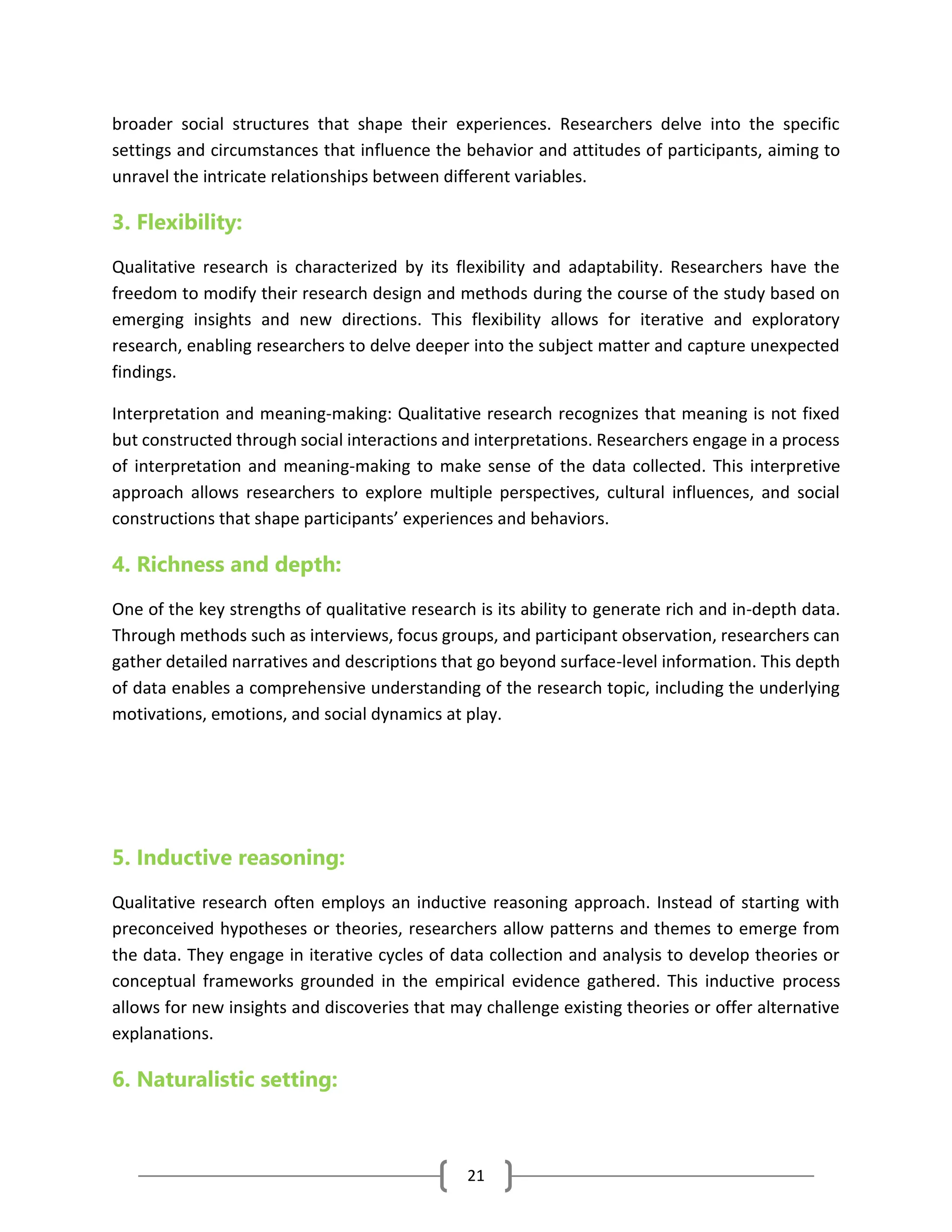
![22
Qualitative research frequently takes place in naturalistic settings, where participants are
observed and studied in their everyday environments. This setting enhances the ecological
validity of the research, as it allows researchers to capture authentic behaviors, interactions, and
experiences. By observing individuals in their natural contexts, researchers can gain a deeper
understanding of how social phenomena unfold in real-world situations.
Three Key Elements of Qualitative Research
Below are the three key elements that define a qualitative research study and the applied forms
each take in the investigation of a research problem.
1. The Design
1. Naturalistic
Refers to studying real-world situations as they unfold naturally; non-manipulative and non-
controlling; the researcher is open to whatever emerges [i.e., there is a lack of predetermined
constraints on findings].
2. Emergent
1. The Design
2. The
Collection
of Data
3. The
Analysis](https://image.slidesharecdn.com/qualitativequantitativeresearchmethods-240428113434-0bb40fc2/75/Qualitative-Quantitative-Research-Methods-docx-23-2048.jpg)
![23
Acceptance of adapting inquiry as understanding deepens and/or situations change; the
researcher avoids rigid designs that eliminate responding to opportunities to pursue new paths
of discovery as they emerge.
3. Purposeful
Cases for study [e.g., people, organizations, communities, cultures, events, critical incidences]
are selected because they are “information rich” and illuminative. That is, they offer useful
manifestations of the phenomenon of interest; sampling is aimed at insight about the
phenomenon, not empirical generalization derived from a sample and applied to a population.
2. The Collection of Data
1. Data
Observations yield a detailed, "thick description" [in-depth understanding]; interviews capture
direct quotations about people’s personal perspectives and lived experiences; often derived from
carefully conducted case studies and review of material culture.
2. Personal experience and engagement
Researcher has direct contact with and gets close to the people, situation, and phenomenon
under investigation; the researcher’s personal experiences and insights are an important part of
the inquiry and critical to understanding the phenomenon.
3. Empathic neutrality
An empathic stance in working with study respondents seeks vicarious understanding without
judgment [neutrality] by showing openness, sensitivity, respect, awareness, and responsiveness;
in observation, it means being fully present [mindfulness].
4. Dynamic systems
There is attention to process; assumes change is ongoing, whether the focus is on an individual,
an organization, a community, or an entire culture, therefore, the researcher is mindful of and
attentive to system and situational dynamics.
3. The Analysis
1. Unique case orientation](https://image.slidesharecdn.com/qualitativequantitativeresearchmethods-240428113434-0bb40fc2/75/Qualitative-Quantitative-Research-Methods-docx-24-2048.jpg)
![24
Assumes that each case is special and unique; the first level of analysis is being true to, respecting,
and capturing the details of the individual cases being studied; cross-case analysis follows from
and depends upon the quality of individual case studies.
2. Inductive analysis
Immersion in the details and specifics of the data to discover important patterns, themes, and
inter-relationships; begins by exploring, then confirming findings, guided by analytical principles
rather than rules.
3. Holistic perspective
The whole phenomenon under study is understood as a complex system that is more than the
sum of its parts; the focus is on complex interdependencies and system dynamics that cannot be
reduced in any meaningful way to linear, cause and effect relationships and/or a few discrete
variables.
4. Context sensitive
Places findings in a social, historical, and temporal context; researcher is careful about [even
dubious of] the possibility or meaningfulness of generalizations across time and space;
emphasizes careful comparative case study analysis and extrapolating patterns for possible
transferability and adaptation in new settings.
5. Voice, perspective, and reflexivity
The qualitative methodologist owns and is reflective about her or his own voice and perspective;
a credible voice conveys authenticity and trustworthiness; complete objectivity being impossible
and pure subjectivity undermining credibility, the researcher's focus reflects a balance between
understanding and depicting the world authentically in all its complexity and of being self-
analytical, politically aware, and reflexive in consciousness.
Basic Research Design for Qualitative Studies
Unlike positivist or experimental research that utilizes a linear and one-directional sequence of
design steps, there is considerable variation in how a qualitative research study is organized. In
general, qualitative researchers attempt to describe and interpret human behavior based
primarily on the words of selected individuals [a.k.a., “informants” or “respondents”] and/or
through the interpretation of their material culture or occupied space. There is a reflexive process
underpinning every stage of a qualitative study to ensure that researcher biases, presuppositions,
and interpretations are clearly evident, thus ensuring that the reader is better able to interpret](https://image.slidesharecdn.com/qualitativequantitativeresearchmethods-240428113434-0bb40fc2/75/Qualitative-Quantitative-Research-Methods-docx-25-2048.jpg)
![25
the overall validity of the research. According to Maxwell (2009), there are five, not necessarily
ordered or sequential, components in qualitative research designs. How they are presented
depends upon the research philosophy and theoretical framework of the study, the methods
chosen, and the general assumptions underpinning the study.
1. Goals
Describe the central research problem being addressed but avoid describing any anticipated
outcomes. Questions to ask yourself are: Why is your study worth doing? What issues do you
want to clarify, and what practices and policies do you want it to influence? Why do you want to
conduct this study, and why should the reader care about the results?
2. Conceptual Framework
Questions to ask yourself are: What do you think is going on with the issues, settings, or people
you plan to study? What theories, beliefs, and prior research findings will guide or inform your
research, and what literature, preliminary studies, and personal experiences will you draw upon
for understanding the people or issues you are studying? Note to not only report the results of
other studies in your review of the literature, but note the methods used as well. If appropriate,
describe why earlier studies using quantitative methods were inadequate in addressing the
research problem.
3. Research Questions
Usually there is a research problem that frames your qualitative study and that influences your
decision about what methods to use, but qualitative designs generally lack an accompanying
hypothesis or set of assumptions because the findings are emergent and unpredictable. In this
context, more specific research questions are generally the result of an interactive design process
rather than the starting point for that process. Questions to ask yourself are: What do you
specifically want to learn or understand by conducting this study? What do you not know about
the things you are studying that you want to learn? What questions will your research attempt
to answer, and how are these questions related to one another?
4. Methods
Structured approaches to applying a method or methods to your study help to ensure that there
is comparability of data across sources and researchers and, thus, they can be useful in answering
questions that deal with differences between phenomena and the explanation for these
differences [variance questions]. An unstructured approach allows the researcher to focus on the
particular phenomena studied. This facilitates an understanding of the processes that led to](https://image.slidesharecdn.com/qualitativequantitativeresearchmethods-240428113434-0bb40fc2/75/Qualitative-Quantitative-Research-Methods-docx-26-2048.jpg)
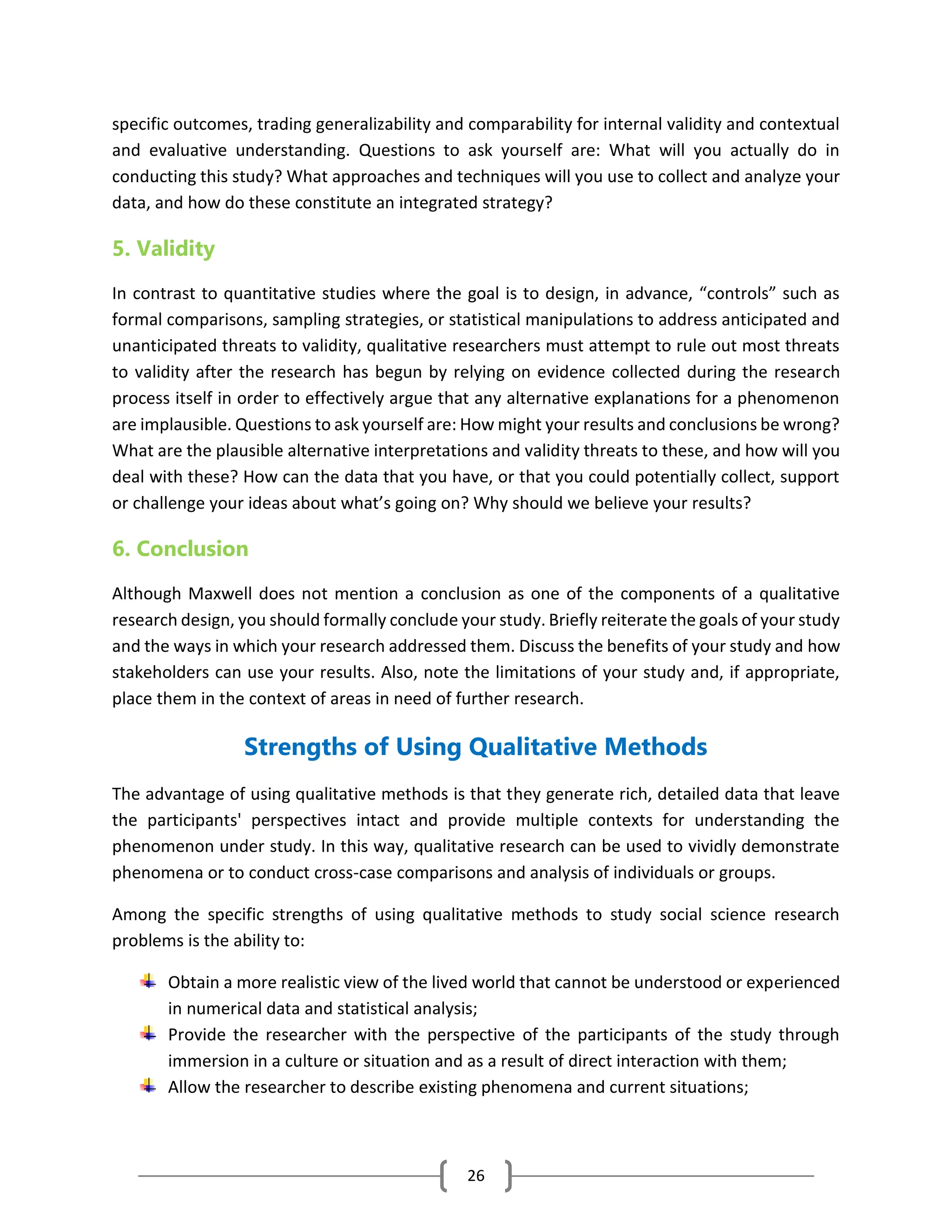
![27
Develop flexible ways to perform data collection, subsequent analysis, and interpretation
of collected information;
Yield results that can be helpful in pioneering new ways of understanding;
Respond to changes that occur while conducting the study ]e.g., extended fieldwork or
observation] and offer the flexibility to shift the focus of the research as a result;
Provide a holistic view of the phenomena under investigation;
Respond to local situations, conditions, and needs of participants;
Interact with the research subjects in their own language and on their own terms; and,
Create a descriptive capability based on primary and unstructured data.
Limitations of Using Qualitative Methods
It is very much true that most of the limitations you find in using qualitative research techniques
also reflect their inherent strengths. For example, small sample sizes help you investigate
research problems in a comprehensive and in-depth manner. However, small sample sizes
undermine opportunities to draw useful generalizations from, or to make broad policy
recommendations based upon, the findings. Additionally, as the primary instrument of
investigation, qualitative researchers are often embedded in the cultures and experiences of
others. However, cultural embeddedness increases the opportunity for bias generated from
conscious or unconscious assumptions about the study setting to enter into how data is gathered,
interpreted, and reported.
Some specific limitations associated with using qualitative methods to study research problems
in the social sciences include the following:
Drifting away from the original objectives of the study in response to the changing nature
of the context under which the research is conducted;
Arriving at different conclusions based on the same information depending on the
personal characteristics of the researcher;
Replication of a study is very difficult;
Research using human subjects increases the chance of ethical dilemmas that undermine
the overall validity of the study;
An inability to investigate causality between different research phenomena;
Difficulty in explaining differences in the quality and quantity of information obtained
from different respondents and arriving at different, non-consistent conclusions;
Data gathering and analysis is often time consuming and/or expensive;
Requires a high level of experience from the researcher to obtain the targeted
information from the respondent;](https://image.slidesharecdn.com/qualitativequantitativeresearchmethods-240428113434-0bb40fc2/75/Qualitative-Quantitative-Research-Methods-docx-28-2048.jpg)
